#which is a tricky proposition because there's only so many products they can make
Text

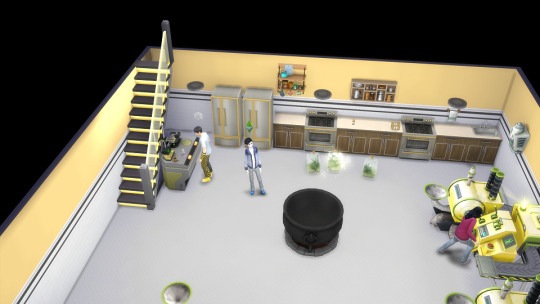
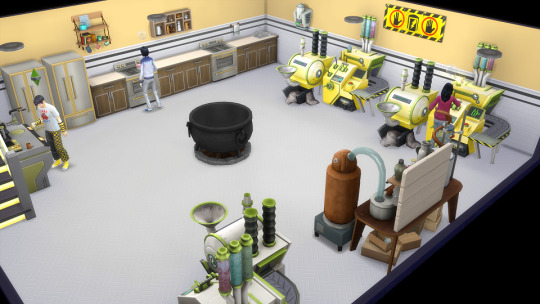
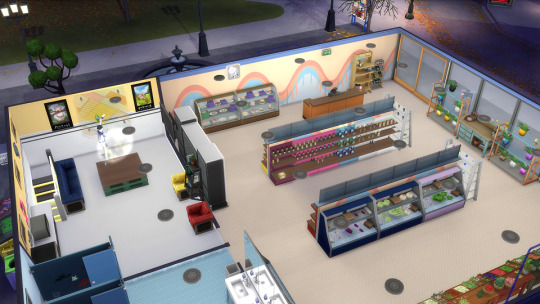


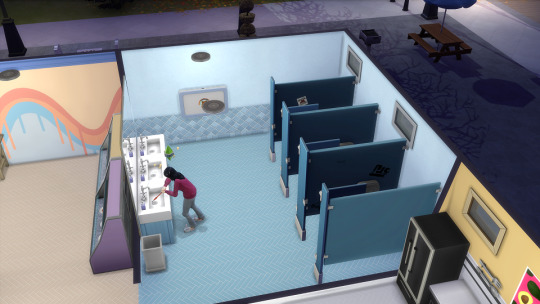
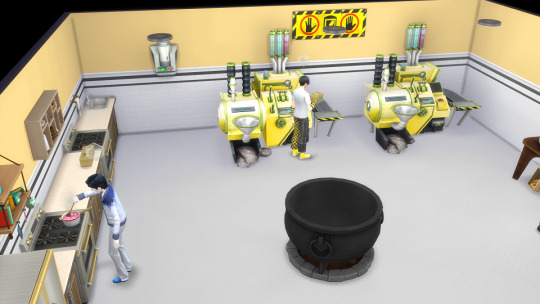






-->After a brief break for socializing, everyone got straight back to work -- Victor Copypastoed some fireflies for Smiler, then made some chocolatey animal treats and an inspiring perfume; Smiler took those fireflies to make spirit-lifting gummies (which got them up to Apothecary skill level 3 in the process, w00); and Alice made more boxes of MREs on the bulk processor. I then followed Victor up as he went upstairs to drop off his bottle of inspiring scent and had him do some more Copypasto (specifically, copying his new animal treats so he didn't have to waste custard making more) --
-->But uh-oh! The thing that I was hoping wouldn't happen had happened -- the flower arrangements that the gang had made near the start of this whole "grocery store" venture had started to wilt! I quickly unmarked all the arrangements for sale and had Victor sell all the bad ones directly -- as they were now covered in flies, he didn't get a good price for any of them, but since all of the arrangements we make here are free, it was still pure profit. Victor then got sent back downstairs to work on deodorant perfume --
-->While Alice came upstairs and stole some meat right out of the meat "department" to eat! Naughty werewolf! >( I guess it's my fault for not immediately marking them all for sale -- the trouble is, I need to have at least one that ISN'T for sale so Victor can Copypasto it! *grumbles* Anyway, she got punished for eating some of the product by having the bathroom sink break on her when she washed her plate -- what you get, girl! At least it didn't take her too long to fix it up.
-->Forbidden snacktime over with, it was straight back to work again -- Victor finished up his perfume, and then discharged so he could get back to Copypastoing everything he could Copypasto; Alice got put back on bulk processing, making tomato sauce and meat substitute; and Smiler took over the flower arranging bench to start replacing the wilted flower arrangements! Specifically, with excellent-quality arrangements that could be scented with bluebells, which make the arrangements "Timeless." That is, I believe they no longer wilt at ALL. Which, given how long it's taken us to fill up this store, I believe is going to be USEFUL. I was prepared to have them work at this for a while --
-->But then I noted the time both in-game and in real life, and realized, "okay, you guys should go home so I can wrap this up." So, after noting what the gang needed in the store (boxes of jam, cheese, more candles, more flower arrangements, etc), and discovering a spare picture from the family reunion still in Alice's inventory (I decided it would look cute on the front desk), I did indeed send the gang home.
Where they were promptly put back to work in the crafting barn. XD Victor was sent to make more candles; Smiler to make more chatterbots; and Alice to make more sugar to use in canning. I left it with her going "screw it, gonna just sleep on the floor here." XD Sorry, I just really, REALLY wanted to get this done!
But we're not quite there yet, so join me next time for another episode of "Time To FINISH FILLING THESE DAMN SHELVES PLEASE" -- "Is Fishing Fun?" edition! Bye!
#sims 4#the lazy save#victor van dort#alice liddell#smiler always#yeah this episode and the next two are all about trying to get the shelves FILLED damn it#which is a tricky proposition because there's only so many products they can make#and some of the products require ingredients that take some time to collect#or can only be collected in certain areas#I mean I'd be SCREWED with Smiler's herbalism stuff if I didn't have Lot51's All Bugged Out Mod#well maybe not full-on screwed since Victor can copy insects but even so#at least they're having more luck getting the apothecary stuff sorted!#those shelves are slowly but surely filling up#not helped by Alice eating some of the product but#well she can always hunt more I suppose#but yeah things are progressing#and things will continue to progress next time#mostly with fish as the teaser suggests :p#queued
2 notes
·
View notes
Text
The Race Is On
Electric vehicles (EVs) have been around a long time now. Just in the modern era, Tesla has been making them since 2003. But the price differential, coupled with range anxiety and access to charging, have made them a tricky proposition for most car buyers. But with gasoline now just topping $5 a gallon, the payback period for these pricey alternatives is finally starting to come into clear view.
In the preceding 19 years, I have frequently crafted cost comparisons for my students to show just how long it would take to break even on an EV. Sure, there have been some hefty tax incentives through the years, including until recently, but those are starting to dry up. When gas was $2 a gallon, you would have to drive many thousands of miles to even come close, unless you just had it in your heart that this was the right thing to do.
And never mind just buying a new car for the hell of it. You have to actually need any new car, EV or ICE (Internal Combustion Engine), because in many cases, it is cheaper to keep driving--and repairing--the old ride before buying a new one.
Today, though, we see EV makers fighting intensely for market share and global dominance of what is admittedly a very small market (only 1% in US, 11% in China, with Europe in between). Volkswagen is now poised to top Tesla at the global level, while both mainstream brands and regional startups are forging ahead with their own entrants.

We are now left to do some math to see if buying an EV--and only if you need a new vehicle--is a worthy pursuit. We will peg gas at $5 for now, and with the average American driving 14,200 miles a year and EVs getting--conservatively--3 miles per kWh charge, we can get to work. Furthermore, electricity averages 14 cents per kWh. A spreadsheet could come in handy, but your phone’s calculator will work, along with paper and pencil. Of course, YMMV, so take this with a grain of mathematical salt.
The average American would thus drives 1183 miles per month, which would cost $55 a month for electricity. If we assume the alternative is an ICE car getting 25mpg, then gasoline would cost $236.60 per month. You thus save $181.60 per month with the EV, or $2179.20 per year.
But wait. We need to factor in that, on average, EVs cost $10,000 more than a standard car. In this model, it would take 55 months (4.59 years) or 61,161 miles to break even.
If gas were to jump to $6 a gallon, as some analysts predict, the numbers change considerably. Suddenly the EV owner saves $227 a month ($282 gas - $55 electricity). The payback period is now 44 months, or only 52,052 miles.
Of course, these analyses assume that gas prices stay high, but we never know. OPEC could flood the market, the Russian war with Ukraine could end, and President Biden could incentivize drilling and constructing more pipelines. Good luck with all that, but it could happen. On the other hand, people who bought gas guzzlers a few years ago never dreamed they would have to endure $5 a gallon, much less $6.
Meanwhile, we are left watching the global theatre of EV production, and companies are doubling down that these are the cars of the future, presidential hopes and wishes not withstanding. If wishes were EVs, then everyone would drive one. We have a way to go, but we are now closer than we ever were before.
Just remember to keep your eyes peeled for charging stations. You might need one.
Dr “Charge Of The EV Brigade“ Gerlich
Audio Blog
3 notes
·
View notes
Text
Healthy Skin Is Just A Few Tips Away!
Do you want skin that is not only healthy but also glows and feels soft to the touch? Do you have scars or dry skin that you don't know how to minimize? Using the tips below, you will learn about skin care so you can be on your way to healthy, beautiful skin!
One of the best things you can do to protect your skin is to make sure you always use sunscreen when outdoors, even on a cloudy day. Sunscreen keeps the damaging UV rays produced by the sun from causing wrinkles. Many sunscreens also contain moisturizing agents, allowing them to serve two purposes at once.
Fast food may taste good, but it is terrible for your skin. All that fat, oil, and grease can really take a toll on your body and your face. Instead opt for eating healthy and nutritious meals at home. You will save money and save your skin.
Finding the perfect foundation at a drugstore can be a tricky proposition. If you want to be sure the shade you're choosing looks as close as possible to your skin, you need to do two things. First, put a dab of the tester on the back of your hand, where the skin will match your facial skin. Secondly, if possible, try to move to where you can examine your hand in natural light. Natural light will give you the best possible idea of how your foundation will look on your face out in the real world.
Avoid tanning booths to keep your skin looking good. While many individuals use tanning beds as a way to look younger by staying tan, this actually results in skin on the other end of the spectrum. More often than no, excessive tanning can lead to skin damage and eventually to skin that looks much older than it is. If you'd like to look young, do something else.
For glowing skin and a healthy body, eat lots of fresh fruits and vegetables, and drink lots of water! At least fifty percent of your food should be fresh fruits and veggies, and you should drink at least 64 ounces of pure water every day. The moisture and roughage in fresh fruits and vegetables work to detoxify your system and keep your insides running smoothly. Pure water washes away toxins for glowing skin.
Shaving your legs and bikini line can leave unsightly bumps on your skin. After shaving, quickly run cold water over your legs to close the pores and liberally moisturize after. Without proper care, your legs will appear red and bumpy with infected hair follicles. Another great way to take preventative care is to use body oil instead of moisturizer after you're done shaving.
To develop thải độc chì mq skin -depth, high quality skincare regimen, you should consult a dermatologist. A dermatologist will provide you with a strong understanding of your skin, and can recommend or prescribe products that are ideal for you. Dermatologist visits are often covered by insurance agents, and seeing one can lower the amount you spend on beauty products in the future.
To give your skin a healthy glow, get at least 30 minutes of moderate exercise a day. mq skin mẫu mới improves your circulation, and helps oxygen to flow to your face. If your circulation is poor, you may look washed out and tired. Regular exercise will keep your face looking as healthy as the rest of you.
Many people having had facelifts may not be fully satisfied with the results because of fine lines remaining around the eyes and mouth. Chemical peels and dermabrasion are treatments to remove the upper surface of the skin. These treatments used in combination with a face-lift procedure will improve the appearance of the fine lines around the eyes and mouth.
It is important to make sure you get enough Vitamin E, which can be found in many food sources like avocados, in order to make sure your skin stays soft and pliable. If you do not get enough, your skin may crack and be vulnerable to infection and other damage.
Get ready to lose those sleeves and long pants because once you start applying these tips, you'll want to show off your skin to the world! Remember to keep up with your skin care because your skin is constantly changing and therefore needs constant care. Just a minute or two of care everyday can make all the difference for your skin!
1 note
·
View note
Text
Two-Faced Commentary
People went really big this week! There were a lot of cool tropes, novel mechanics, and a surprising number of white cards with hexproof.

@alextfish - Manifold Core
The front side of this card is a very powerful cost reduction effect, especially given that it applies to a set of cards that often don’t have any colored mana in their costs. I suspect that would often function as a combo piece in decks that don’t intend to transform it, to a degree that it overshadows the rest of the card a bit, but the overall flavor is good. The card is also very aggressive when transformed on turn 4, although that you need to four-for-one yourself to get the creature serves as a powerful check.

@bread-into-toast - Guilt-Wracked Artist
A genuinely horrifying card concept. I’m not 100% sure that I follow what the treasure represents in the story (the key?), but it’s still very unnerving.
Mechanically, the card holds together reasonably well, in that if you get the card in the graveyard the “right” way, then it’s easier to pay the disturb cost, and the mutual discard plays reasonably with a graveyard-focused strategy.

@decayingbooks - Graceful Swan
This is a great transformation trope, and a very strategy-heavy flip card. Flip cards that gain value by flipping back and forth are established design space, with Huntmaster of the Fells being the most notable, but this card adds the additional wrinkle that, once you’ve accumulated enough bird tokens, you want it to be night on your own turn to take advantage of the ability to buff your tokens. (Although both activated abilities do have value on your opponent’s turn.)
While it’s doing reasonable flavor work, the ability that makes your bird creature tokens humans may be overkill. There’s nothing wrong with trinket text, and in a set with human tribal elements it could be genuinely relevant, but the card is already fairly complicated.
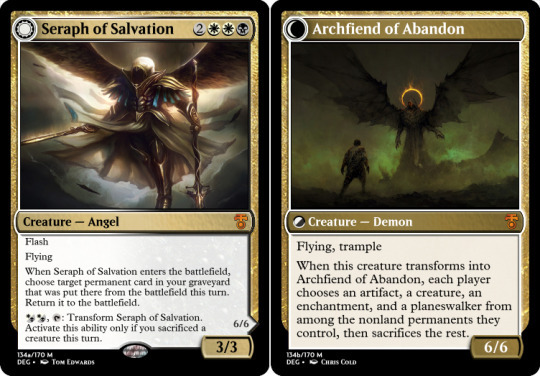
@deg99 - Seraph of Salvation
The creature revealing its true demonic nature (or falling angel, but my understanding is that this is the former) trope is a good fit for a TDFC. There’s a ton packed into this card - the front side on its own is very flashy, and threatening an instant-speed Mythos of Snapdax once the card is on the field changes the way the game is played significantly. (Wrathing at instant speed is a big deal.) The mechanics of each side don’t feel all that strongly connected, but they make enough sense on their own. I like the aesthetic decision to leave the demon W/B rather than making it mono-black, as its effect is more strongly associated with white.

@dimestoretajic - Zosusk, Cruel Taskmaster
The front half of this card is extremely strong. Even at four mana, a super-Ashnod’s Altar that can go in the command zone is a scary proposition, especially given that it’s also difficult to remove and can cash itself out for a treasure if it would die. The indestructibility is arguably overkill, especially as the card can generate a lot of value even if it is removed right away.
Similarly, I’m not sure if the back half particularly needs hexproof; if you’ve got any kind of board, it generates a lot of value, and I think that on balance it’s better if that’s answerable.
The idea of a card that’s sort of a side-grade when transformed is interesting, as is the tension about whether or not to cash out your creatures if it’s going to transform, and I like that the tension is abated a bit by the fact that both halves make sense in the same deck, even though they operate differently.


@fractured-infinity - Velis, Distorted Reflection
This is a really clever twist on the Evil Twin design space. The back side is very powerful, but the effort required to get there is real and meaningful, and the front side is enough of a slightly bad deal on its own that the transformation ability isn’t just a freebie. Needing to specifically see a creature with the same name die is also fairly clever, as it means that Velis needs help to transform. (You can’t just crash Velis into whatever it’s copying.) The back side does have a pretty high level of inevitability; once you’re at six mana, you can effectively “steal” any creature your opponent plays before they can attack with it, and in Commander can be used to keep other commanders off of the field. This latter feature might make this card safer as a non-legendary creature.

@gollumni - Ral, Untapped Potential
The front half of this card makes a lot of sense as a Ral card. The sparking condition doesn’t tie directly into Ral’s own sparking story in any obvious way (he sparked when he discovered his partner was cheating on him), but it mechanically ties into what the character is about and strongly enables his fairly stiff sparking condition.
If I have a quibble with this card, it’s that you often won’t be able to productively make use of Ral the turn he flips. To do so, you’d need a fourth instant or sorcery that you can cast that turn, this time at full price, and if it’s a very cheap spell then the amount of value you’re getting is pretty modest.

@greensunzenith - Escape from the City
What I think really elevates this card above the basic idea of a Saga that transforms into a creature is that it does something with the lore counters after transforming. Unless I’m missing something, haste on Hazoret is mostly superfluous, as it will nearly always have been on the battlefield from the beginning of your turn when it transforms. (It could still matter if you double proliferate or if it changes controllers, I guess.)
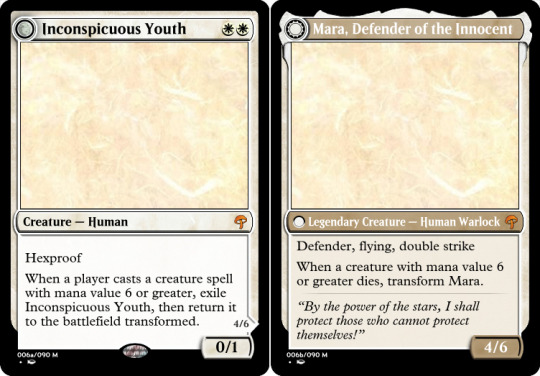
@grornt - Inconspicuous Youth
This card is another fantastic choice for a transformation trope. This one does a magical girl transformation in a non-obvious but flavorful way, where the character transforms specifically in response to a major threat, and then reverts when the threat is gone. That it transforms even when the major threat is your own card feels like an acceptable flavor bend for the sake of making the card playable, and that it reverts as soon as any major threat is gone is a reasonable choice for simplicity. (It could also check for 6 MV creatures at the end of the turn.)
I went back and forth on whether I liked the back half having defender. On one hand, it allows the back half to be far bigger and scarier than if it didn’t have defender; without that, the transformed half needs to shrink or the card needs to cost more. It’s also fine flavor. On the other hand, it really gums up the board, as it’s very difficult to profitably attack into the card. Additionally, it kind of creates an “...oh” moment when reading the back.
Lastly, I think that a white creature just straight up having hexproof is a bit of a bend (although not one wholly without precedent.) The flavor helps justify it (and it’s definitely mechanically relevant), but flavor can justify a lot of things.
Despite these questions, I do really think the design is very clever, and it was one of my favorites from this week.
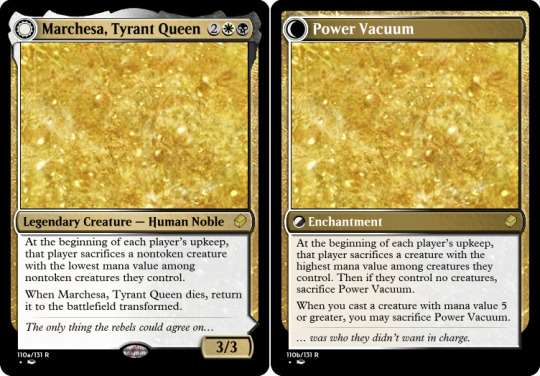
@helloijustreadyourpost - Marchesa, Tyrant Queen
The mirrored Abyss effects are clever together, and the flavor helps to sell the shift. The nontoken clause on the first side is doing several interesting things in terms of not only making the card a bit stronger as a control tool, but in helping enable the flip. Giving opponents a natural out on the back side helps check the overall power level of the card as well, and I think it’s a positive that any wrath is an answer for the back half in Commander. While the flavor makes sense and it certainly makes the card stronger, I could take or leave the second ability on the back.

@hiygamer - Penultimate Form
I like that this card cleverly ties the “quest” condition to something that the reverse side of the card will naturally need. I also think that the triggered ability on the back is extremely clever, in that helps make the card less tricky. Without the triggered ability on the back, there’s a not-immediately-obvious interaction where casting instant spells in response to each other allows the creature to transform with five loyalty counters on it, which is a major advantage in that the card can use its -4 ability right away and survive. Stealing a creature is extremely powerful protection for a planeswalker and strong in general. However, because a similar ability is present on the back, players don’t need to recognize that stacking instants correctly allows the planeswalker side to start with five+ loyalty counters, as you can get the same effect by just casting them in sequence.

@hypexion - Sigarda, Fallen Grace
The transform condition on this card is quite difficult, even with the amount of Eldrazi token-making available and its ability to fuel itself, but the front half is plenty strong. Large, evasive, efficient hexproof creatures are something that I think they shy away from a bit now (and white rarely gets creatures that just have unconditional hexproof), although the throwbacks to Sigarda’s first card are clear. While the back half of the card is a meaningful upgrade, the front half is strong enough that it stands on its own - many decks may not worry about flipping the card at all.

@i-am-the-one-who-wololoes - Ormendhal Weakened
Ormendhal is a potent abyss effect, and having it wait until your upkeep to trigger for all players is a good safety choice - it gives your opponents a healthy window of time to respond to it. The backside is something of a consolation prize, as in many circumstances it will operate like a basic Plains, but the flavor is interesting. I don’t totally understand the decision to allow the land to tap for colorless instead of just white; outside of an environment where colorless mana costs exist, it won’t make much of a difference, and while there have been Eldrazi on Innistrad (and Ormendahl was affected by Emrakul), the connection seems a little loose to justify what’s otherwise an unusual line of rules text.
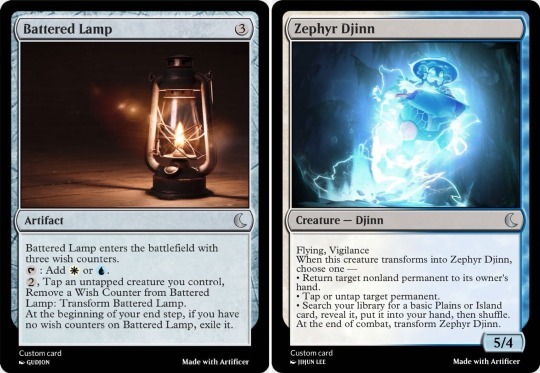
@jsands84 - Battered Lamp
This is a really fun design. That you need another creature to “rub” the lamp is a cute piece of text, and allows for other costs on the card to be pulled down to really attractive levels
The degree of inevitability on this card (5-power, evasive, bounces any blockers your opponent has, requires either artifact destruction or instant-speed creature destruction), along with its complexity, might push it to rare, although I like that the numbers work out such that this doesn’t win the game on its own.
I’m not sure whether this is intentional, but you can effectively get “infinite wishes” by having Zephyr Djinn bounce itself when you transform it for the last time. It’s enough of a tempo hit that I don’t think it’s a power level concern, and if you’ve already made (and probably attacked with) a 5-power evasive creature twice, then there’s a good chance that you’d rather attack with the Djinn the third time than to bounce it, but I felt that it was an interaction worth pointing out.

@kellylogs - Klara, Embereth Aspirant
This is a sufficiently clean, elegant transform condition that, even though this is not an existing planeswalker character, tells a clear story. I do feel like the backside of this card could be a bit stronger; if you’ve successfully attacked alone with Klara, blockers may not be something that’s causing you problems, and in an aggressive deck a 3/2 with Exalted may be at least as powerful planeswalker side in many scenarios. (Although being able to get a 2/2 Vigilance creature right away means that you don’t fall back much in terms of board presence.)
The -7 ability in particular could probably also use a bit more juice. While it’s technically a three-turn ult, its impact disappears if Klara does, and the +2 ability required to get to it is pretty weak (especially on the turn when Klara transforms, where it will generally do nothing.)

@misterstingyjack - King Pakesh II
The two sides of this card are loosely mechanically connected (they both like it if your opponents’ creatures die, although both halves can also be fueled in other ways), but the flavor helps tie them together. I think that limiting the front half to one treasure/turn is a good decision both in that it helps keep the cost of the card down and in that the card isn’t so good that you don’t care about the back half. Both halves have unique mechanics that still feel reasonably elegant and flavorful, and I like that the card doesn’t try to do too much. This is also a cool recontextualization of Disturb in general.

@morbidlyqueerious - Niko, Quizzical Javelineer
You mentioned that this card is revised from an earlier contest where the goal was to make a card that included every letter of the alphabet, and while that shows in the card’s name, the overall package isn’t stretching or squishing tooooo much to meet that criterion. Niko offers a larger amount of repeatable scry that exceeds what’s generally printed, although needing to connect with what’s otherwise a gray ogre to get it makes it such that it’s not likely to fire too many times in one game. The flip condition is challenging enough that I think the strongish +2 ability on the reverse side is justified, especially as it will often leave Niko vulnerable. If anything, I think the reverse side could perhaps be a smidge stronger.
I’m not sure whether this is intentional or not, but I do think that it’s interesting that it’s easier to meet the card threshold for the when you’re on the draw, but easier to meet the unblocked attack condition when you’re on the play.

@naban-dean-of-irritation - Will, Stoic Cryomancer
This is a pretty clever way of handling a flip walker that represents power sets found in two different colors, and the card does a solid job of feeling like a tag team. Another cool thing about this card is that it defies the legendary rule as long as you leave both copies on different sides.
If I have a critique of the card, it’s that I do think it’s a bit difficult to reach Will’s ult, however. If you play the card on curve (turn 3), you generally can’t flip it until turn 4. From there, you need to use the +2 three times to get to 10 loyalty, which is only possible if your opponent consistently has at least two creatures. That takes you to turn 7, which means that you can use the Ult on turn 8, making it a five-turn ult (or four turns if you were able to flip Will on turn 1). The ult only does something, however, if you control another planeswalker. While the ult is not a big deal on a planeswalker that’s this flexible, I think it could be a smidge cheaper. (-9 would save you no turns on building to it, but means that you don’t need to have another walker in play to use it.)
I’m also not sure if overtly making typeless permanents is something that’s worth putting on a card, given the potential confusion. The rules can handle it, and there are ways of making it happen in-game already, but similar gameplay can be achieved in more conventional ways.


@nicolbolas96 - Ugin, Last Among Elders
This is another card where the front half is almost worth it on its own, so the relatively steep flip requirement is fine, as it serves as more of a bonus. Life gain and card draw aren’t the things I most strongly associate with Ugin, but the card draw works as a mirror of Nicol Bolas, the Ravager, and the package is sort of like a miniature version of Ugin’s ult.
This is a small thing, but I wish Ugin was a bit bigger than 3/3. I realize that the similar Nicol Bolas, the Ravager, is only a 4/4, but 3/3 feels a bit small for an Elder Dragon.
The planeswalker side is recognizably Ugin, serving as a sort of greatest-hits of his associated cards. The novel ultimate will win the game on the spot in any deck built around it, but as you spent 5+8 mana on Ugin already and upticked it three times, that’s totally fine.

@nine-effing-hells - Mysterious Ruins
It’s not totally obvious which part of the ability the Revelation ability word refers to, but overall the card tells a clear story. A land that transitions into cardflow in the late midgame and a (kinda) finisher in the late game makes a lot of sense, although opponents that are too worried about the reverse side can save a kill spell for it. A land that enters the battlefield untapped doesn’t need to do much else to be good, so the high overall investment required to flip it is a good decision. Decks that want this sort of effect will tend to be controlling decks that can make better use of the mutual draw as well.

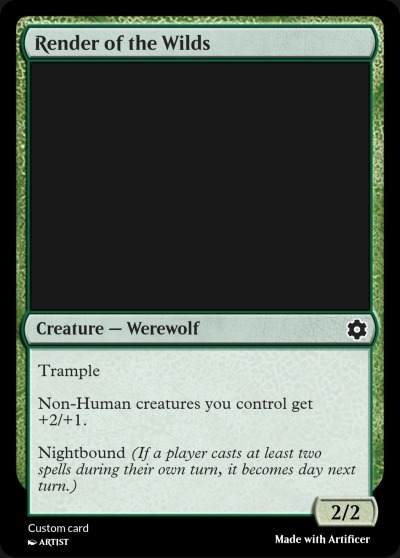
@partlycloudy-partlyfuckoff - Tender of the Wilds
The names on this card are clever, and help tell a different story than the superficially similar Mayor of Avabruck.
This is a very strong effect; the back side in particular is both large for a 2-mana werewolf and has a very strong anthem effect. While a good fit for a werewolf deck, this card is strong enough to go almost anywhere (and the front half is slightly better in a non-werewolf deck.)
This is a minor thing, but the more common templating for abilities like the backside has is to roll the stats it provides into the creature itself (printing it as a 4/3) and then to print the ability as “Other non-human creatures you control...” However, I think the templating you’ve chosen is potentially reasonable on this card for the sake of mirroring the front half.
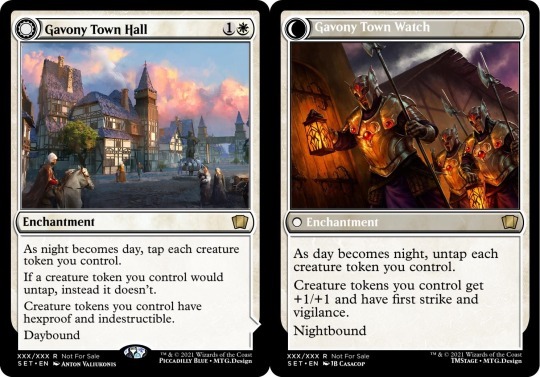
@piccadilly-blue - Gavony Town Hall
This is a very difficult card to evaluate, because its impact on the game can vary a ton depending on how things are ordered.
This needs to go in a token deck to do anything at all, but the day-side drawback of turning off all of your creatures is harsher than the anthem on the back is beneficial, if you’re trying for an aggro strategy. On the flip side, there’s a lot of potential to gum up the board quite a bit with indestructible hexproof tokens if you play the card after your token producers. Token strategies already sometimes gum up the board, and this creates the potential for game stalls. Your opponent can get around this by passing their turn to shift to night, but that’s a fairly major tempo loss, and it sets you up well for the crack back.
I do like that there’s some interesting things that can be done with wraths and with creating token copies of cards with powerful static effects while on the day side.

@pocketvikings - Covetous Vizier
One of two “genie of the lamp” cards this week, I believe that this card is specifically a reference to the Disney movie Aladdin. (I could be wrong about that - I’m not super familiar with genies.) This card is basically Phylactery Lich on an installment plan, although you spend more total mana and some life. Additionally, your opponent has a window of time to respond with creature removal, which is not the case for the Lich. In compensation, the front half of the card can be played profitably even if you control no artifacts. Black does, as of Midnight Hunt, apparently get 2/3 creatures with upside for 1B at higher rarities, but a 2/3 for 1B with a useful effect is already, on its own, a satisfactory creature. The first question I had with this card is why it wasn’t just a lich, but not every card needs to use the most obvious or most-established flavor for an effect - and it’s more memorable that it doesn’t.

@quillpaw - Shellcrown Phoenix
A few different phoenix cards - Everquill Phoenix and Rekindling Phoenix - have used complicated tokens to try to mimic this effect, and a few DFC cards represent hatching eggs, but this card is novel in combining them, and I think it works really well.
The one slight oddness with this card is that it’s possible to miss your chance to transform it back, if you don’t have the mana (or don’t wish to spend the mana) to flip it at the time that the last counter is removed. It’s possible to play around this by attacking with fewer creatures, but I don’t think that the card as a whole is so strong that this limitation is necessary. Additionally, due to the cost of the card and the flip condition, I feel like the game will often be over before the card can flip back, but it still has utility in getting the last bit of damage in in a gummed up board state.

@real-aspen-hours - Gathering Storm
The front half of this card is very strong, offering heavy levels of card selection at a reasonable price on a card type that’s relatively difficult to interact with. I don’t know that it’s over the top (three mana is a lot for just selection), but the card doesn’t hinge completely on
I respect the decision to use a simple transform condition. I feel like the “obvious” angle is to condition it on having a certain number of cards in your graveyard, and that’s potentially safer (the current version will, I think, sometimes be flipped with just one very strong card in your graveyard), but even that requires some building around, so it’s probably not that big of a deal. I do like giving players a decision

@reaperfromtheabyss - Wavewhisper Egret
This is a lot of card for a two-mana uncommon. The front half would be an attractive card even without the ability to transform, and the transform effect will generally scry at least 4. Blue can get 2-power fliers with upside at higher rarities on occasion, but this is certainly a very aggressively-costed version of this creature profile.
I also think the decision to flavor this as a card from Kaladesh, rather than from New Phyrexia or Alara, was an interesting one. It injects a bit of light horror into a setting that doesn’t have much of that.

@shakeszx - A Tempest Foretold
Having the saga exile itself and return transformed is an elegant way to kill two birds with one stone, dealing both with the sacrifice clause on the card and helpfully disposing of the now-irrelevant lore counters.
I’m not 100% sure how to parse the first ability on this card - I’m assuming that it’s meant to pull from your graveyard or cards you own in exile (and maybe the stack), since those are under most circumstances the only zones that will have instant and sorcery cards in them when the ability resolves that aren’t your hand, but as written it sort of reads as though you can grab cards from places like your opponent’s graveyard. The rules do intervene to stop you from putting other players’ cards into your hand, but I feel that the wording on this could be clearer.
I’m also not sure that the back side works the way we want it to. In cases of cards that exile themselves on resolution, I’m not sure that Izzuke will recognize that it’s the same card, and any other card will go to the graveyard upon resolution, where it won’t be recognized as the same card if it’s then exiled again. (The rules could maybe be altered to support this, but it’d create additional complications.) Additionally, I’m not sure that exiling your hand in order to slowly potentially get the instants and sorceries back one at a time really feels worth it; Izzuke is a good deal for four mana, but even with Ward 4, the blowout potential is pretty huge. If your opponent saves any removal for it, you’re very likely to lose.
All that said, the general concept of a saga that builds up a resource that the creature it flips into can expend is a strong one.

@snugz - Queen Bee
Assuming that you hit your land drops and that nothing happens to your drones, this card will flip after two land drops, having created seven 1/1 fliers. The reverse side will then make these fliers 2/2’s, three of which can attack right away (assuming this occurred over two turns). In most formats, this means that your opponent is going to be dead before the long-term value aspects of the card come into play. They are still relevant in Commander and as a rebuilding option if your drone army gets wrathed, and the flavor is good, however.
On the whole, the card may be a little too efficient at building a game-winning board, especially as it is hard to remove if not removed immediately. I think the card could do fewer things and still work as a card, even though all of the individual components make flavor sense.

@starch255 - Cursed Knight
There’s a lot of things I really like about this card. I like that its toughness is low compared to its power, so it will usually either kill something or die in any combat with another creature. I like that the Frog side is still a knight. This feels like a reasonably in-pie way to give white a well-above-the-curve creature, and if your opponent doesn’t have an answer or a body to throw in front of it, this puts out much larger life swings than two-mana uncommons normally ever do. Even if your opponent tosses a 1/1 in front of this, you’re still up a bit.
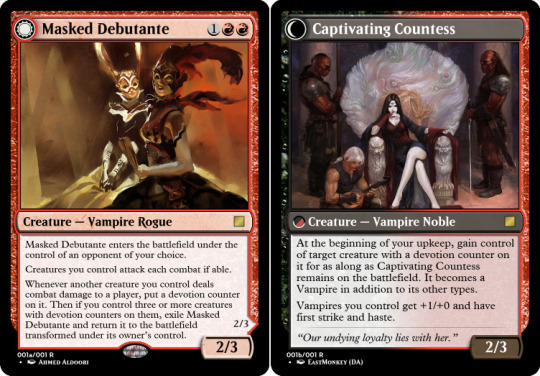
@whuh-oh - Masked Debutante
This card has a lot of moving pieces, but the overall package makes sense. The actual power level of the card hinges a lot on your opponent having at least three creatures already in play, but there are enough outs to it that it doesn’t feel hopeless in any case. I also like that the creatures have to actually hit you to get the counters, limiting the total amount of value you can steal. I also like that the card doesn’t have any sort of anti-sacrifice mechanism built in; it’s game-winning enough of the time as it is, and doesn’t need to have what answers do exist for it to be shut off.
I’m not 100% sure that the creature-stealing is really a red thing, but tying it to the survival of the creature helps, and in general makes the card much more fair.

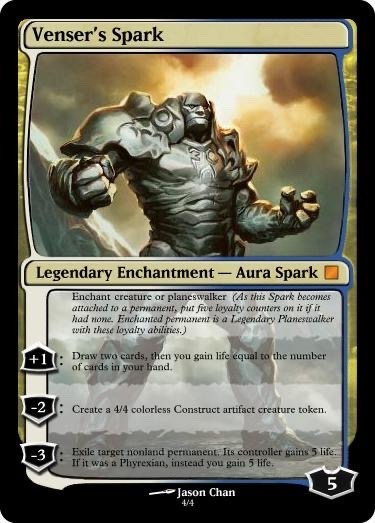
@wilsonosgoodmcman - Venser, Close to Death
In inventing a new card subtype, this is the most ambitious card for this week. I also like the flavor of a doomed planeswalker having only minus abilities, and lining up the planeswalker so that it needs to die to using one of its abilities (or take damage on your turn, I guess) is a nice little minigame that isn’t trivial, but also is easy enough that you can usually expect to flip Venser if your opponent doesn’t have a substantially greater board presence than you.
The third ability on Venser should probably target only other permanents, to avoid confusion about what happens if it targets Venser, but that’s pretty minor. (I’m assuming that the intent is that it doesn’t flicker Venser.)
Even though it costs you (usually) a creature and the effort of flipping Venser, I think that the +1 on the reverse side might be a bit much. While all of the abilities are powerful, that one stands out as especially tough to beat.

@wolkemesser - Keepsafe Bear
This card tells a cool story, and I appreciate the work you did in balancing the difficulty to flip the card. At first, I sort of felt like it went a little overboard in terms of preventing you from flipping it (you basically need a wrath or for your opponent to block it or attack into it with a much larger creature), but the front half and back half are both strong enough that I think it’s okay for there to be some fairly specific hoops.
The back half does just enough, I think. There’s an alternate design for this card where the back half loses indestructible and the front half is harder to flip, and that version is probably a bit easier to print, but I think there’s a place for the higher-challenge version presented here as well.
12 notes
·
View notes
Text
Someone on the Discord brought up fertility
Just like last time I'm lazy and just going to dump it instead of editing.
[5:10 PM] Me: Oh boy, I have thoughts about this
[5:12 PM] Me: I haven't brought it up here but demographics has been one of my covid obsessions. I got a couple books about it (What to Expect When No One's Expecting, One Billion Americans, etc.), read all the articles, etc.
[5:15 PM] Me: I agree with you about a couple things: namely that if we had "infinite free energy" we'd be a a lot better off in many ways including demographically, but I disagree with most of your other points.
[5:18 PM] Me:
Also we need not assume decline in population growth is chronic.
This is a tricky statement because there's a social aspect and a mathematical aspect. Socially you're correct in the sense that whatever trends are driving the current decline could, in theory, reverse at any time. But mathematically, population decline is exactly symmetrical to population growth: it's exponential (technically it's logistic, but that's the same as exponential in the short term), because having fewer people means fewer people to make more people later on.
[5:20 PM] Me:
Infact there is some evidence to suggest that we actually did more science when we had 4-6 billion people.
I disagree with the implication here: we used to do more science because there was more low-hanging fruit, which is now plucked, and further discoveries require more resources (human and financial). Actually one of the big reasons I disagree with Ray Kurzweil and the other singularitarians is that when they show these impressive-looking exponential curves about scientific progress, they quietly hide under the rug that these increases are requiring ever-more investment (again, in both people and money) to accomplish. Just to pick a random example, every time chip manufacturers go to a new process (14nm -> 10nm -> 7nm -> 5nm -> 2nm etc.), the cost to build the fab basically doubles. I remember a couple years back Intel had to spend $5 billion to hit a new process shrink; now TSMC needs to spend $28 billion to hit their next target: https://www.wsj.com/articles/tsmc-to-spend-up-to-record-28-billion-in-advanced-chips-capacity-11610623587)
[5:23 PM] Me: I will try to find it but I came across a paper a little while ago laying out in detail that the cost of new scientific discoveries has been steadily increasing over time. It's not that there's anything necessarily going wrong with the scientific process, this is just what you'd expect as we pick low-hanging fruit: the later discoveries necessarily become harder. But if you extrapolate that trend out forever you eventually hit a point where every single person needs to be a scientist, and every dime of capital in existence, needs to be used to make any new discoveries.
[5:26 PM] Me: (In most fields we're a long way from that point, but it actually is here or nearly here in e.g. particle physics. What I have been hearing from leading-edge particle physicists is that we've got maybe one or two more generations of particle accelerators left before we reach a point where, to probe any further (e.g. to see if string theory is true), we'd need to build accelerators the size of the Solar System, which would take more raw material than the mass of the Earth. Barring some new theoretical breakthroughs, we might actually nearing the "end" of high-energy physics.)
[5:30 PM] Me: Fortunately most fields aren't at that point, but my point is that the more we discover, the more human capital is required to make further progress. That's a tricky enough proposition with a growing population, never mind a shrinking one.
[5:36 PM] Me:
I don't think it is safe to assume lowering population growth is a biological disorder so much as a conscious choice most people in the younger generations are making for a variety of obvious reasons.
I agree with this, but it's important to dig into that a little and understand the reasons. For example, I'm not yet convinced that there is a mass epidemic of people choosing childlessness because of anxiety about e.g. climate change. In internet comments sections you certainly see lots of people making that claim, but talk is cheap and randos on the internet can say whatever they want. In terms of the actual reasons, the data I've seen shows that number of children continues to track closely with a couple data points, mostly housing costs, expected lifetime income and uncertainly about future income flow.
[5:40 PM] Me: Third, I think you should give more weight to the concerns Rhys brought up than you currently are. The environmental stresses of more people is certainly a big issue, but I think it's one that can be dealt with without too much struggle with increased deployment of clean energy (one of the few optimistic data points lately is that there's a staggering amount of wind and solar power being deployed every year) and a couple of lifestyle changes like eating less meat. Not to say these are easy, but contrast with the pretty serious problems of population decline, particularly the social safety net.
[5:41 PM] Me: And I don't just mean the explicit ones like Social Security, but even market-based, privatized ones like retirement savings have a hidden reliance on a growing population.
[5:42 PM] Me: When you "save for retirement", you're not stockpiling food and water to live off when you no longer work, you're collecting financial assets that you expect to sell to someone else and live off that income. But if there's no one to sell to, that doesn't work.
[5:44 PM] Me: This is a problem that's starting to show up at the top end of the income stack: see this WSJ article about retirees who can't find anyone to buy their $3 million homes: https://www.wsj.com/articles/a-growing-problem-in-real-estate-too-many-too-big-houses-11553181782. It's easy to have schadenfreude here at those poor rich people who can't unload their huge mansion, but remember that this is inherently a problem which will start at the top of the income brackets and gradually make its way downward.
[5:46 PM] Me: You can push this problem back for a while by increasing taxes on the rich, and I do indeed think those should go up, but in a declining population that only buys you a little time. Remember that "money" is nothing but a claim on some fraction of total economic output. e.g. when you hold a dollar bill, you're essentially holding a note entitling you to one-zillionth of American GDP.
[5:47 PM] Me: At a certain point once population falls then total aggregate output necessarily falls too, and at that point taxing the rich hits rapidly diminishing returns: you're just claiming a bigger share of falling output
[5:49 PM] Me: One thing to keep in mind here is that most economies, but especially the U.S. economy, are primarily driven by consumer spending, i.e. normal people just buying and selling stuff to each other.
[5:50 PM] Me: This is why e.g. mass immigration isn't as huge a deal as a bunch of nativists like to think: immigrants get jobs, but they also spend money on goods and services just like anyone else: they generate labor demand as well as taking up supply
[5:51 PM] Me: But what I'm driving at here is that, again, a consumer-spending-driven economy with a falling population is going to get poorer pretty much by definition: fewer people buying stuff means fewer jobs to produce that stuff.
[5:54 PM] Me: Or to put another way, to use a ridiculously simplified model, GDP = Population X Productivity, and so if you take the derivative, then GDP' ~ Population' + Productivity'. So in a falling population environment, you need a lot of heavy lifting in terms of forever-increasing productivity in order for economic growth to be positive. And while there might be improvements down the pipe, frankly we kind of seem tapped out on productivity growth already
[5:55 PM] Me: Now, one possible response here is that we should work out how to have an economic system which delivers prosperity without endless growth, and I do agree we need that. But just saying that doesn't fix the problem that right now we don't have it and people will be poorer in a world without growth.
[5:56 PM] Me: And in such a world, I think it actually becomes harder to successfully transition to whatever post-scarcity economy can fix the problem, because people will be caught up in fighting over a shrinking pie.
[5:58 PM] Me: The neoliberal capitalist mindset of "a rising tide lifts all boats" isn't totally true and has been used to justify all kinds of nasty plutocratic behavior, but it isn't entirely false either. Without growth, at least in the system we have now, wealth distribution inherently becomes a zero-sum game. And that could get really ugly.
[5:59 PM] Me: So, that's most of what I have to say about why a falling population would be bad. But that's the easy part. Where this gets really complicated is why it's happening and what to do about it
[6:00 PM] Me: Now, I think one of the reasons I've been so fascinated by this is that it's been a pessimistic year, and falling birth rates are kind of the perfect pessimistic problem because I don't really see an easy way out. Also I'm just annoyed by partisans in general, and this is a perfect problem for that because it sort of frustrates partisans on all sides.
[6:02 PM] Me: e.g. the left mainly talks about the economic causes and proposes a variety of policy solutions, but an ugly little secret here is that government policy to increase birth rates has basically a perfect, unbroken track record of total failure
[6:03 PM] Me: All kinds of countries (mostly in Europe, but also in East Asia) have implemented all kinds of pro-natalist policies, and for the most part they have accomplished pretty much nothing. (Amusingly, this even goes back to antiquity: in the first couple centuries AD Roman Emperors were also concerned with falling birth rates, and implemented a variety of reforms that didn't do anything)
[6:03 PM] Me: You could always say they didn't go far enough, but at some point you're making an unfalsifiable hypothesis
[6:06 PM] Me: Meanwhile on the right, they're constantly talking about cultural factors, but this runs into two problems: it's again a set of mostly unfalsifiable hypotheses, but even worse since they're all tangled up in the Right's usual rants about The Way Things Ought to Be, but even if they turned out to be true, it seems like a hopeless cause because we basically have no levers to change culture.
[6:07 PM] Me: "Why does culture develop in the direction it does" is one of those huge questions I'm not sure we'll ever have a complete answer for, but I think it has to mostly involve technological determinism.
[6:08 PM] Me: https://www.sciphijournal.org/index.php/2017/11/12/why-the-culture-wins-an-appreciation-of-iain-m-banks/ <-- this is a great article explaining what I'm talking about, as well as explaining why you should read Iain Banks
[6:09 PM] Me: But my point here is that all the cultural changes the Right laments as causing people to have fewer children, assuming they're even correct which I am definitely not granting, are pretty much all products of industrialization. You can't roll them back without undoing the Industrial Revolution. At least not without an insane level of authoritarianism
[6:10 PM] Me: So on the policy side we have a bunch of levers which don't do anything, and on the culture side there are no levers at all.
28 notes
·
View notes
Text
That Needy Pervert and the Ghost with the Most: Beetlejuice on Stage and Screen
The 1988 cult classic film Beetlejuice starred Michael Keaton as the eponymous "bio-exorcist" who cons a recently deceased young couple into hiring him to scare living people out of their house. After a long journey through many different incarnations, the story found its way - albeit in a vastly altered form - to Broadway in the form of a hit musical starring Alex Brightman in the title role.
Despite the title, neither story actually centres the stripy garbage man. The film follows Adam and Barbara Maitland as they struggle to adjust to their own deaths; the play tells the story of sixteen-year-old Lydia Deetz as she struggles to adjust to her mother's death. In the former, Beetlejuice (or Betelgeuse, as it's spelled onscreen) is strictly an antagonist, and in the musical he serves as narrator and antihero.
Making villains sympathetic is tricky territory. It often leads to a disturbing willingness among audiences to gloss over, or even actively excuse, atrocities committed by a character as simply the "dark side" of a misunderstood and lonely soul. This was a risk with the stage adaptation: making the audience root for a character who is sexually predatory and casually homicidal is sketchy as hell, but the stage production makes Beetlejuice sympathetic with an enormous emphasis on "pathetic".
Michael Keaton's Beetlejuice has fears, but no apparent insecurities; Alex Brightman's Beetlejuice is riddled with insecurities while somehow being fearless. They are, in many ways, opposites: the former is dangerously invulnerable, and the latter is dangerously vulnerable. Keaton's Beetlejuice wreaks havoc because he doesn't care about consequences, while Brightman's doesn't understand consequences.
Both Beetlejuices obviously display toxic masculinity, which the stage version lampshades very unsubtly. (Actual quote: "as a society, we don't teach men to process their anger, so maybe I'll just try murder!") Stage-Beetlejuice - or BJ, as he dubs himself on several occasions - is flamboyant and occasionally effeminate in his mannerisms; when it comes to gender roles, he appears to give no shits. He paints his nails, dyes his hair purple and is openly bi. In situations where men are expected to hide their emotional vulnerability, he lets it all out - but not in any kind of healthy or positive way. This isn't a progressive, modern guy expressing his feelings instead of bottling them up; it's an incorrigible douchebag whose liberation from societal norms has only made him more of a selfish dick.
Notably, however, the stage production doesn't fall into the common trap of using female characters as rehabilitation centres for fucked-up men. Or any characters, for that matter! They all see right through his poor-widdle-me bullshit and make it clear that they expect better. They don't accept his excuses. And while he does eventually improve, the story doesn't suggest that you, too, could reform an asshole in real life by following the same methods as the stage Maitlands and the Deetzes - because when dealing with an asshole in real life, you can't just kill them until they learn their lesson.
Film-Beetlejuice is never redeemed, but there was never really any need to redeem him. Stage-Beetlejuice kind of needs some form of redemption - if he doesn't get that, we feel guilty about rooting for him, and with good reason: he's a sadistic, murderous sexual predator! That's not somebody you want to support.
(Note: I've already hinted at a few spoilers for the stage version, which is, to quote its opening number, a bold departure from the original source material. From now on, there will be full spoilers for the play.)
Film-Beetlejuice is killed before he can secure his place in the world of the living by marrying Lydia. (We last see him being punished in the afterlife.) Stage-Beetlejuice does marry Lydia - but for very different reasons. She devises a plot that exploits his biggest vulnerabilities: his fragile ego and pathetic need to be adored, combined with the toxic masculinity she recognises within him.
It seemed to me that BJ was never attracted to Lydia prior to Creepy Old Guy. He's immature at the best of times, but around Lydia he acts like an actual child, albeit a murderous one. We know from experience that when he is attracted to somebody, he never hesitates to proposition, sexually harass, grope, pinch, or kiss them without their consent - none of which he ever did to Lydia. Additionally, all his lines in COG are about how this makes him feel loved even though he knows it's totally gross. (Of course, he's still guilty of sexual misconduct against almost every adult in the cast.)
All in all, unlike real-life scumbags, you can take out your righteous anger on BJ as much as you want - and it actually helps. It's cathartic; it's a wish fulfillment. You can literally murder the guy to teach him a lesson, and he actually learns the lesson. It's beautiful.
#beetlejuice#broadway musicals#gay baby movies#lawrence beetlejuice#toxic masculinity#Alex Brightman#Michael Keaton#Tim Burton#Betelgeuse#the musical. the musical. the musical.#maureen i'm not a theater person
52 notes
·
View notes
Photo


THE HOUSE OF YES by Wendy MacLeod Directed by Matthew Parker The Hope Theatre 8 – 26 October 2019 Interview with Matthew Parker by Heather Jeffery Matthew Parker has had 5 Best Director Offie nominations covering productions from 2015 to 2018. He’s constantly challenging himself and coming out on top. “I don’t take anything for granted. All I do is work as hard as I can and some of them fly and some of them don’t. I never go into room thinking I’m going to smash this; I go into a room terrified.” Becoming Artistic Director of The Hope Theatre in 2015 is what got him noticed. He’d been at The Hope for less than 6 months, when LOVESONG OF THE ELECTRIC BEAR, a play about Alan Turing, won three Off West End Award nominations as well as best director. He is leaving The Hope at the end of this year which will allow him the possibility of working on larger stages. It will be a fresh challenge for him after getting so comfortable with the space at The Hope. At this point in time, Parker has just started rehearsals for THE HOUSE OF YES, but he already has ideas about staging and how to best use his beloved space at The Hope Theatre. THE HOUSE OF YES is about a family living in the shadow of the Kennedy clan but none of the Kennedy’s actually make an appearance in the play. It’s set in 1983, 20 years after the assignation of JFK. The character Jackie O in the play has an obsession with the Kennedy’s along with her whole family. Parker puts it in a nutshell. “They live opposite the Kennedy’s and they are absolutely loaded. It’s a big white house, golden toilets ridiculously rich. They’ve only ever had or will only have people say yes to them. No one has ever said no to anything.” Parker’s been looking at the politics of the time. “There’s a surge of capitalism and loss of society. The rich looking after the rich … Wall Street” he says with relish. “The world changed in the 80s … coming out of 60s 70s people could make themselves. Those 80s films like Trading places, Working Girl, getting rich quickly - that business and money happened in this country too, with Maggie Thatcher and the yuppies.” Matthew runs a course at DRAMA STUDIO LONDON on Stagecraft which explores the idea of ‘significant events’ in Western history and how they change things. So, he’s concentrated on finding the milieu of the family, a mother and her three children, two of whom are twins (male and female). The twins were children when JFK was assassinated. “It’s an obsession with lots of Americans” Matthew explains. “Everything across the world that happens in America changes things. The text gets changed; people talk about 9/11 – normally we’d say 11.9. Something like JFK creates art, creates films. It changes the world and rocks the world making people feel unsafe.” “We had two Princess Diana’s – Before she died, she was a woman vilified in the press but when she died, she became the people’s princess” says Matthew. “The newspapers completely changed text on her” says Parker “and I find that fascinating. There’s a connection between JFK’s assignation and this family in THE HOUSE OF YES because they live opposite, they feel personally affected. Americans feel it, the whole world feels it.” For Parker it’s all part of his stage craft, not just digging into the text but looking at the other things surrounding it, it isn’t just about character, it’s the world of the play. And what a world it is! It’s comedy but it’s also described as a ‘twisted play’ and it isn’t the first of such plays that Parker has chosen to direct. So, what’s in it for him? “I like things that look at the dark underbelly of society” he says, “that look at the dark side of our psyche.” He doesn’t have any personal reasons for feeling that way, but he really likes to get an audible reaction from his audiences. “I really like it, when one member of the audience finds something that’s really funny and another finds it really horrendous. I like to affect the audience’s breath, and I love to get a vocal reaction, a gasp or a laugh.” “Look at the programme THE THICK OF IT or VEEP; these are people in power who are horrendously awful to each other, but we find it tremendously funny. This is black humour, dark comedy.” For Parker there’s also the element of a challenge. In the past he’s directed musicals, farce and an absurdist play. THE HOUSE OF YES is also tricky to pull off as Parker explains. “Tonally it’s the same challenge I faced with THRILL ME; to get the tone right because some of the behaviour that these characters display is despicable. As a director with a team, we’re not shying away from it but at the same time, we’re not being exploitative.” The set is also proving a tricky proposition. “This play is very short at approximately 70minutes straight through but it moves between two rooms and it keeps moving. I’ve never done that before. It’s a mansion”, he pauses for effect. “We can’t do two ginormous mansion rooms in The Hope. It’s a big white pillars, white wedding cake house, flitting between rooms - don’t know how I’m going to do it yet, but I think the scenes will bleed into each other. As one finishes, the next scene starts around it.” He’s thinking maybe a big chaise, that can be both a sofa and a bed in the bedroom. “I love a scene change, making something out of a scene change, choreograph it with a shift of light for each different space” says Parker, the relish clear in his face. Curiously enough, this piece wasn’t Parker first choice for his final show at The Hope. He’s had a couple of shows in mind, but he didn’t get the performing rights. Two of them are so popular, running number one tours which means that the big theatre companies buy the rights in perpetuity and no one else can get them. He’s been trying for ten years for these two titles but to no avail. Then his sound designer Simon told him about this play; that he really should read because it had all the things he likes. Its female led, it has dark areas of psyche and elements of horror. “It’s a very fast, intense read” says Parker. “I’d not even finished the first scene and I went …” Parker bangs the table with the flat of his hand for emphasis “… I want to do this. It’s quite unlike anything I’ve read before. the dialogue is so distilled, nobodies trying to obfuscate, people say what they mean. No chaff, just wheat.” He hasn’t yet met the writer, but he knows that she regards the play as “Noel Coward comedy of manners meets Pinter”. It has a fascinating psyche underneath it. “It’s scalpel and knives, pointed, sharp, clean and clear” says Parker. “It will make you laugh, make you gasp, and it will make you recoil in terror”. His way into the drama is the fifth cast member, the outsider Lesly (girlfriend to the male twin). “She has no idea how horrendous they are” says Parker, “because on one ever told them no, so when normal people step in …” He lets this stand in the air. “She’s a working-class woman and she stands up to them.” With almost 1,000 applicants for the roles, Parker had a job whittling them down. He’d already cast the mum. Gill King works with Parker at Drama Studio London and he’d wanted to work with her for many years. It will be a “challenge” for both of them says Parker as they’ve never worked together as director and actor, but whenever he comes across someone he wants to work with, whether it takes 10 years, he won’t forget. “I will you get you in next time I can”, he says. There were plenty of people he’d dearly love to work with, but when he’s reading the play, he never thinks about casting. “The first time you read a play is the only time you’re going to be getting nearest to the first impression that the audience will see” he says. “I try to think what my first impression is of this story, write loads of notes, go back to it during the rehearsal process. Otherwise it’s not being able to see the wood for the trees. So many things come out in rehearsal and so many things at the first preview, when an audience first watches.” > Bart Lambert as Anthony Colette Eaton as Jackie O Gill King as Mrs Pascal Kaya Bucholc as Lesley Parker is no stranger to comedy, and he knows how it works. “In rehearsal with a comedy like THARK, which Parker directed at the Drayton Arms in 2017, we’re dealing with high farce, it’s a vocal word gag, say it in a certain way and you can get a ‘tshh’ cymbal noise at the end of it. There’s a physical laugh button and you’ve got to know where the button is. Not everybody will laugh in the same places all the time but often there is a rhythm one can tap into which means that most of the time it will elicit a laugh” Parker is attracted to audience who will react as they want to, and he has a very dark sense of humour. He also likes clowning. “There’s a danger when something funny lands in rehearsals and everyone laughs. You’ve got to keep doing that every time. After a few rehearsals the actor may think it’s no longer working because it’s no longer getting a laugh. If something works, we’ve got to remember that in three weeks time, because that did land.” “We have no way of knowing how people are going to react. We’re constantly looking at - what is the story here? Laughs have to come out of that. Even when an audience is deathly silent it doesn’t mean something hasn’t worked/” Parker is also aware that some audience are following others’ leads, so he keeps as silent as possible when watching his own shows. “No one wants to hear the Director laughing at their own work! Cringe! It’s the audience members that matter” he says. “So long as they don’t hurt anybody, they can do whatever they want. They can react to the story as they want. Some people miss that and think the most important person in the room is the director, actor or writer. Its’s not! It’s who you do it for - the audience - and it’s our collective job to give them a good time. I cannot guarantee it, but I do everything I can to try to.” Matthew Parker was interview by Heather Jeffery, Editor of London Pub Theatres Magazine Photographer credit is lhphotoshots @September 2019 London Pub Theatres Magazine All Rights Reserved THIS SHOW HAS ENDED THE HOUSE OF YES by WENDY MACLEOD Directed by MATTHEW PARKER At The Hope Theatre, Islington, N1 1RL, 8 – 26 October 2019 Box Office: 0333 666 3366 http://www.thehopetheatre.com/productions/the-house-of-yes/ Just what happens when you grow up in a house that only says “yes”? Meet the Pascals. A family living in the shadow of the Kennedy clan. Outside their Washington D.C. home a hurricane is raging. Inside, at the eye of the storm, a series of twisted and dangerous events have been set in motion that can only have one destination. It’s Thanksgiving, 1983. Jackie-O is beyond excited to have her twin brother Marty home. He’s excited too, but for different reasons. He’s bringing home his fiancée to meet the family. Younger brother Anthony is impressed, perhaps worryingly so, and mother Pascal is too zoned out on pills to be paying much attention to anything. The scene is set for an evening of twisted machinations and mind-games that will leave the players with scars that will never ever heal. The multi award winning Hope Theatre presents a rare revival of Wendy MacLeod’s deliciously dark comic drama given cult status by the 90’s film starring Parker Posey. By arrangement with Josef Weinberger Limited, London Press on THE HOUSE OF YES: “Wickedly funny, disturbing and vividly written” San Francisco Chronicle “Gripping, funny and worth its reputation” Time Out London Press on Matthew Parker’s previous shows at The Hope Theatre: ★★★★★ “Juxtaposes the absurd, the horrific and the comic” Act Drop ★★★★★ “Beautiful, unsettling, dark & gripping” London Theatre Reviews ★★★★★ “Taut, sinister and ultimately disturbing” The Review Chap ★★★★★ “Another stunner from The Hope” IThankyou Theatre ★★★★★ Dark and disturbing” London Theatre1 ★★★★★ “Uniquely brilliant” Views From The Gods Twitter: @TheHopeTheatre @TheHouseOfYesH1
2 notes
·
View notes
Text
Apple Pie
I’ve said it before, and I suppose I will be saying it long into the future: What goes around, comes around. In fact, I said it not too many blogs ago. It’s just that, while innovators are still busy innovating, much of what passes for new today is really just a new spin on an old thing.
And one of those old things we have already talked about this term, complete with its new wrapper: Buy Now, Pay Later (BNPL). It’s called installment shopping. Credit. Whatever you want to call it when you make your payments spread out over time, but you get to enjoy the product now.
During inflation, this becomes an especially compelling option, because higher prices are causing many shoppers to defer purchases. You know when people are looking to discount grocers as a way to save money, then times are tough. But, as we have discussed before, about 70% of our economy is consumer-driven, and if we don’t keep buying, then the economy can and will suffer more. It’s our moral and patriotic duty to keep buying. I suppose. To a limit, right?
There’s one item that many of us have been using BNPL for years, and that is our smartphone. I have been making monthly interest-free installments on phones for as long as I can remember. My carrier (AT&T) often has promotional offers that tease me with upgrade choices so I can get the latest phone, yet just keep merrily making my monthly payment, seemingly to infinity. It’s a nice loop, isn’t it? In fact, it kind of guarantees a shopper in perpetuity, because you become vested in the process.
Which may help explain why Apple and Best Buy just partnered for Apple’s new Upgrade+ program on select MacBook Pro laptops. The program allows shoppers to buy a new computer with 36 easy payments, and then a balloon payment in Month 37. A $999 laptop, for example, is only $19.99 a month until the very end, and then there’s the $280.35 finale.

But if you choose to stay in the program, you can simply trade in your three-year-old laptop for a free upgrade, avoid the $280 payment, and keep rolling with the $19.99, which in my estimation is a no-brainer. Who in their right mind would want to get off this merry-go-round when you can swap a big balloon payment for another three-year set of cheap and easy?
I just wish I had known this were coming a month ago, when I bought my latest MacBook Pro. The old one was coughing up blood, to put it mildly, and it was time. I have been a Mac user since 2005, and with all the other gadgets I own (like phone, iPad, and more), I have an ecosystem of Apple products. They do play very well together, don’t they?
Had this option been available, I would have jumped at it, because there is no doubt in my mind I will be a Mac user until I die. To be able to spread out the payments rather than making a much more painful $1500 purchase is far more appealing.
BNPL has thus far been the mainstay of third-party banks and credit organizations, and this one is no different. Citizens Pay is the underwriter on this one, and like the others, the whole thing depends on the consumer making their monthly payments, lest hefty penalties accrue.
While I did not get to take advantage of this for my laptop, I am seriously thinking of this option for the new camera body I plan to buy this year. Sony just announced the new aR7v, which clocks in at $3899. And that does not include any lenses. It’s a Ferrari among Hyundais. But to be able to spread it out over 12 payments (still a hefty $325), it’s a pill that is much easier to swallow. I have the cash, so I could just buy it now and call it good. But if I could kick that can down the road for a year? Niiiiice. Better yet if I put that money to use to make even more money.
The primary risk for everyone, of course, is over-extension. We must all be careful to make sure we can indeed afford the monthlies. Credit card debt—which is what this really is—has long been a tricky proposition. It’s what helps prop up our economy, but can become suffocating if done to excess.
I suspect that Best Buy needs a program such as this to stimulate sales, because they recently turned in a rather dismal Q2 FY23 report, showing a 12.1% decline in revenues from the previous year. That’s huge. Going into the holidays, Best Buy needs to start hitting home runs, not bunt singles. They won’t win any World Series games with such pathetic results.
All of which means that if this flies, don’t be surprised if Best Buy looks to do more of it across more brands and categories. Our economy is depending on it. Their employees and stockholders are depending on it.
And in the end, buying more stuff is as American as apple pie. I mean Apple. Skip the pie, Best Buy by and by. It goes around, and comes around.
Dr “Wish I Had Waited“ Gerlich
Audio Blog
0 notes
Text
Helpful Tips For Skin Care And Beauty
New Post has been published on https://innersoulhealthandbeautyreviews.com/helpful-tips-for-skin-care-and-beauty-8/
Helpful Tips For Skin Care And Beauty
You have always wanted to find out about or possibly, enhance your current knowledge of how to take care of your skin and have scoured the internet for information to help you. The tips and tricks we provide in this article, when followed as suggested, should help you to improve your skin care.
When caring for your skin, don’t forget about the areas immediately around the eyes. These areas require special moisturizing treatments, since this skin does not produce its own oil like the rest of your face. A nightly treatment with an eye area cream can keep unsightly wrinkles from forming around the eyes.
If your current day cream or lotion does not contain ingredients to protect your skin from the sun, consider mixing in a lightweight sunscreen. Ideally, your facial products should offer SPF of at least 15. Seek out skincare with sun-loving ingredients like vobenzone, Helioplex, or micronized zinc. These ingredients offer broad-spectrum coverage without affecting the appearance of the skin’s coloring.
To keep the skin on your hands looking young, exfoliating is a good option. By exfoliating the thin skin on the hands at least once a week to remove the top, dead layer of skin, this uncovers smooth, new skin which then retains moisturizers better to keep hands looking and feeling great.
Purchase pomegranate pills from your local health store to help protect your skin from the sun. These pills raise your resistance to the sun, and help you tan instead of getting sunburn. These pills are natural and absolutely harmless to your body. Their only effect is to make your skin healthier.
Before going to sleep, clean up your face from any trace of make-up. Apply a moisturizer a few hours before going to bed so that it has time to penetrate your skin and will not clog your pores while you rest on your pillow. Apply lip balm and hand cream before going to bed.
Skin care comes with many different tools. One of the more handy ones is a regular washcloth. Washing with a washcloth daily offers gentle exfoliation to the skin, and once you start using them on a regular basis, you will notice a big difference in the condition of your skin. Clean the washcloths regularly, and hang them to dry between uses.
Finding the perfect foundation at a drugstore can be a tricky proposition. If you want to be sure the shade you’re choosing looks as close as possible to your skin, you need to do two things. First, put a dab of the tester on the back of your hand, where the skin will match your facial skin. Secondly, if possible, try to move to where you can examine your hand in natural light. Natural light will give you the best possible idea of how your foundation will look on your face out in the real world.
To summarize, there is quite a bit to learn about skin care. Do not be overwhelmed though, because there is a lot to take in. Depending on your situation, either your continued skin health or the start of a new healthy skin lifestyle, is dependent solely on your willingness to learn and also the personal commitment that you invest.
0 notes
Text
Nvidia RTX 3070 review: AMD’s stopwatch just started ticking a lot louder
Talking about the RTX 3070, Nvidia's latest $499 GPU launching Thursday, October 29, is tricky in terms of the timing of today's review embargo. As of right now, the RTX 3070 is the finest GPU in this price sector by a large margin. In 24 hours, that could change—perhaps drastically.
Ahead of AMD's big October 28 event, dedicated to its RDNA 2 GPU line, Nvidia gave us an RTX 3070 Founders Edition to test however we saw fit. This is the GPU Nvidia absolutely needed to reveal before AMD shows up in (expectedly) the same price and power range.
Inside of an Nvidia-only bubble, this new GPU is a sensation. Pretty much every major RTX 2000-series card overshot with proprietary promises instead of offering brute force worth its inflated costs. Yet without AMD nipping at its heels, Nvidia's annoying strategy seemed to be the right call: the company established the RTX series' exclusive bonus processing cores as a major industry option without opposition, then got to wait a full year before competing with significant power jumps and delectable price cuts.
Last month's RTX 3080 saw that strategy bear incredible fruit—even if ordering that $699 GPU is still seemingly impossible. But what happens when Nvidia scales down the Ampere 7nm promise to a $499 product that more people can afford? And how will that compare to whatever AMD likely has to offer in the same range?
Future-proofing around the 1440p threshold
We can only answer some of those questions today. (Until Nvidia proves otherwise, we assume that availability will continue to be a massive asterisk for this and all other RTX 3000-series cards.) In good news, at least, the RTX 3070 gets off to a roaring start by rendering its 2019 sibling, the RTX 2070 Super, moot. Both debuted at $499, but the newer option typically approaches, and occasionally bests, the RTX 2080 Ti (whose $1,199 MSRP in 2018 sure feels like a kick in the ray-traced teeth nowadays).
But RTX 3070's price-to-performance ratio comes with one significant caveat: a not-so-future-proofed VRAM capacity of 8GB, shipping in the not-as-blistering category of GDDR6. That matches the best RTX 2000-series cards but is surpassed by higher-speed GDDR6x VRAM in pricier RTX 3000-series GPUs.
The thing is, "future-proofed" for PC gaming is relative. What's going to matter in 3D processing in the near future, both for the games you love and the systems you run them on? If you're set on having the crispest native 4K rendering for the foreseeable future, the RTX doesn't leapfrog over the 2080 Ti, particularly with a VRAM allotment that could stress any games that ship with 4K-specific texture packs.
But if you're favoring a lower-resolution panel, perhaps 1440p or a widescreen 1440p variant—and Steam's worldwide stats make that a safe assumption—then your version of future-proofing revolves more around processing power and ray-tracing potential. In those respects, the RTX 3070 currently looks like the tippy-top option for a "top-of-the-line" 1440p system... with the bonus of Nvidia's Deep Learning Super-Sampling (DLSS) for surprisingly competitive fidelity in 4K resolutions, should gamers upgrade their monitor between now and the next GPU generation. (Until AMD shows us otherwise, Nvidia's proprietary DLSS 2.0 pipeline remains the industry's leading upscaling option, and game studios have started embracing it in droves.)
In other words, if you're more interested in high frame rates on resolutions less than 4K, and you want GPU overkill for such a CPU-bound gaming scenario, the RTX 3070 is this year's best breathing-room option for the price... at least, unless AMD announces an even more compelling proposition on October 28.
Strong, but not the 2080 Ti topper we expected
The above collection of game benchmarks mostly mirrors the ones I used for my RTX 3080 review, and once again, these tests err on the side of graphical overkill. You may have zero interest in using an RTX 3070 with 4K resolutions or maximum graphical slider values, and that's understandable. Instead, these tests are designed to stress the GPU as much as possible to present the clearest comparisons between the listed cards. Look less at the FPS values and more at the relative percentages of difference. (The exception comes from "DLSS" tests, which I'll get to.)
Even though this year's $499 RTX 3070 clearly exceeds the power of last year's $699 RTX 2080 Super, I tested it against last year's $499 RTX 2070 Super as well to show exactly what a difference a year makes in terms of price-to-power proposition. The percentage differential between the 70-suffix GPUs varies based on what kind of software you're testing, but the most massive surge in performance can be found when ray-tracing effects are toggled at pure 4K resolution. Wolfenstein Youngblood, in particular, sees the 3070 double the 2070 Super's frame rates in its ray-tracing benchmarks.
While Nvidia has made benchmarking claims that put the RTX 3070 ahead of the RTX 2080 Ti, that doesn't necessarily bear out in my testing—but this is because the RTX 2080 Ti Founders Edition shipped in 2018 with a remarkable capacity for safe overclocking. The 3070 FE, like its 2070 Super sibling, seriously lacks headroom for such safe overclocking for either its core or memory clocks, as managed by tests-at-every-step automation by programs such as EVGA X1. Testing was nearly identical on the 3070 with or without a scant EVGA X1 overclock applied, and as such, I've left its OC tests out of this roundup. Remember: as Nvidia's Founders Editions go, generally, so do other vendors' variants. So we're not sure other vendors will squeeze much more out of the same model.
Thus, the 2080 Ti still pulls ahead in most, but not all, of the above gaming benchmarks, whether ray tracing is or isn't enabled. When comparing both cards' specs, this difference checks out, since the newer 3070 cuts back on certain components for efficiency's sake (not to mention that dip in VRAM capacity). Categories like Tensor cores and RT cores are listed as "newer-generation" versions for the 3070, and the bigger 3000-series cards beat the 2080 Ti both in quantity and generation, so they get the clearer wins. The 3070 finally sees that efficiency trade fail to win out in certain testing scenarios—nothing tragic, mind you, but worth noting in case you'd hoped for across-the-board wins against the 2080 Ti. That's 184 "third-generation" Tensor cores in the 3070, versus 544 older Tensor cores in the 2080 Ti, and 46 "second-generation" RT cores in the 3070, versus 68 older RT cores in the 2080 Ti.
Size, ports, noise
The RTX 3070's efficiency figures into its size reduction, down to 9.5 inches in length (242mm) from the RTX 2070 Super's 10.5 inches (but not quite as small as the original RTX 2070's 9-inch length). Like other 3000-series FEs, the RTX 3070 utilizes what Nvidia calls a "flow-through" design that pulls cool air from below and pushes hot air out in two directions: through its "blower," out the same side as its DisplayPort and HDMI connections, and upward in the same direction as your motherboard's other components. Basically, the size reduction may help you cram an RTX 3070 into a smaller case, but you'll still want to guarantee considerable airflow.
Speaking of connections, they're identical to what you'll find on the RTX 3080: three for DisplayPort, one for HDMI 2.1. (If you missed it, Nvidia quietly dumped the VR-friendly USB Type-C "VirtualLink" port found in most RTX 2000-series cards from this year's GPU generation, perhaps owing to how few VR headset manufacturers bothered supporting it.) Additionally, the 3070 continues the RTX 3000-series trend of employing a smaller 12-pin connector for power, though it ships with an adapter for today's common 8-pin PSU standard. In the 3070's case, it only requires one 8-pin connection to a PSU, not two (or a mix of 8-pin and 6-pin), even though it maxes out at a 220W power draw. (The 2070 Super requires one 8-pin and one 6-pin connector with a power-draw maximum of 215W.)
And when Nvidia brags that the RTX 3070 runs quieter, the company means it. While I lack solid decibel-measuring equipment to tell you exactly how much quieter this card runs than its competition, it's safe to say that its full-load mix of fan noise and operational hum probably won't be the loudest component in your system. And with my ear directly up to it, its noticeable noise certainly wasn't louder than, say, a PlayStation 4 Pro. (Nvidia has described its noise level as "up to 16dBA quieter" than the original RTX 2070 Founders Edition.)
Thoughts on 1440p, ray tracing, and DLSS
The above benchmarks make clear that 4K/60fps performance in newer PC games, with all settings maxed out, isn't a given on the RTX 3070. But it's important to note that many of these tests include overkill settings for things like anti-aliasing, shadow resolution, and even "maximum" ray-tracing effects, all meant to guarantee maximum GPU impact for the sake of accurate comparisons between the GPUs. In the real world, you can safely drop most of these from "ultra," "extreme," or "insane" while still exceeding most console ports' settings and barely looking discernible from their over-the-top maximums, and the results often land darned close to 4K/60.
Scale down to a resolution like 1440p and you'll hope for frame rates that take advantage of monitors rated for 144fps and above. One good indicator of the RTX 3070's capabilities is Borderlands 3, a particularly demanding (and arguably inefficient) game that doesn't leverage Nvidia-specific GPU perks while packing its scenes with dynamic lighting, alpha particle effects, cel-shaded detail, and massive draw distances. When put through its benchmark wringer at 1440p on my testing rig (i7-8700K OC'ed to 4.7GHz, 32GB DDR-3000 RAM), BL3 averages 99.5fps at the "high" settings preset or 88.0fps at "ultra." Not 144fps, mind you, but I think of BL3 as a good "floor" for performance, easily outdone by older and more efficient 3D games.
Without ray tracing turned on in 3D games from the past few years, RTX 3070's frame rates have easily surpassed 80fps with tons of bells and whistles enabled at 1440p resolution, and they've easily gone higher with every drop in settings from there. But what happens on the RTX 3070 with ray tracing turned on?
As of press time, there's an interesting combined trend for just about everything I've tested with some version of DirectX Ray Tracing (DXR): the harmonious pairing of Nvidia's latest "DLSS 2.0" standard. Should you run GPU-pounders like last year's Control or this month's Watch Dogs Legion at near-max settings and 1440p resolution, plus ray tracing enabled, you can expect frame rates at roughly 50 to 55fps on the RTX 3070. But a funny thing has happened with DLSS 2.0: much improved support for DLSS upscaling from 906p to 1440p. Last year, I would've told you that you were crazy to upscale from anything lower than 1440p, in terms of pixel smudginess.
When testing at 1440p, Control has seen its DLSS 2.0 translation of tiny details, particularly text on posters, improve compared to native rendering plus temporal anti-aliasing (TAA). Meanwhile, WDL's benchmark is keen on adding rain to its mix, which is clever on Ubisoft's part; this is the exact kind of detail that DLSS has struggled to render in games like Death Stranding, yet in this newer game, rain materializes almost identically when its 906p signal is upscaled with DLSS' machine-learning wizardry.
With both of these games' DLSS modes toggled at this 906p upscale, frame rates jump to the 78-84fps range... and that's with ray tracing enabled ("high" RT settings in Control, "medium" RT settings in WDL).
A masterful game of GPU dominoes
Nvidia really couldn't have set these dominoes up any better. Its RTX line of GPUs has separate components to handle the above fancy features—dedicated ray-tracing cores and dedicated "tensor" cores to handle ML-assisted computation. The way its ray-tracing cores work lines up neatly with industrywide standards like DXR, which means it's a drop in the programming budget to implement those in ways that will work on competitors' GPUs and on brand-new gaming consoles. And the tensor cores' upscaling methods line up neatly with TAA, a particularly common anti-aliasing standard that Nvidia's DLSS effectively piggybacks off. As of DLSS 2.0, the model does not require game-specific coding to work (though developers still have to partner with Nvidia to implement it). For Nvidia gamers, then, the ray-tracing proposition going forward is clear: if you want to turn it on, you'll almost certainly have the simultaneous option of toggling the efficiency of Nvidia's dedicated RT cores and the efficiency of their DLSS implementation. In terms of pixel fidelity, DLSS 2.0 has pretty much proven to be a wash, with games generally enjoying a mix of sharper and blurrier elements depending on the scene (with neither being egregious, with the notable exception of Death Stranding's peskiest, super-detailed moments like cut-scene details and screen-filling rain). And that's a wash visually, not computationally; the proof is in the frame-rate pudding.
We still don't know if AMD can possibly compete when its future cards have their ray-tracing modes turned on. Maybe we're in for a $500-ish scenario where AMD can beat Nvidia's rendering performance in a game like Borderlands 3 at a better price-to-performance ratio, only to lose out on the same performance gains with ray tracing turned on. Having tested Watch Dogs Legion over the past week, I can safely say its RT perks—as slathered over a massive, open-world city full of reflective surfaces and other handsome light-bounce effects—are difficult to disable now that I have a midrange GPU that can reasonably handle said effects at "1440p."
Meaning, I could turn them off... but I no longer want to. It's hard to go back to plain ol' rasterization after seeing so many light sources realistically emerge no matter what time of day or scenario I'm in. As I pilot a drone past a shiny office building, or drive in a shiny, future-London car past a beautiful landmark, I see objects in WDL reflect or bounce light in ways that acknowledge objects or light sources that otherwise aren't on the screen. This is what ray tracing does: it accounts for every nearby light bounce, even if it's not on screen, to render the whole world whether you can see it directly or not.
Plus, if you have dreams of one day toggling ray-tracing power at 4K with this card, WDL on an RTX 3070 at "high" settings gets up to a 58fps average in 4K resolution with RT at "medium," so long as I use DLSS to upscale to 4K from... wait for it... 1440p native. Those upscaling results are convincingly crisp, as well.
Thus, as I said in the beginning, your definition of a "future-proofed" GPU will likely drive your interest in what the RTX 3070 has to offer for $499. We're about to see even more interesting ray tracing in games—including at least one we're not allowed to talk about yet. You'll have to take our word for it, in terms of how exciting it is to live inside of some games' ray-traced worlds.
If that's not your bag, due to visual preferences or budgetary reasons, I get it. But it remains to be seen whether a cheaper RTX card can deliver the same future-proofing in the 1080p range or whether AMD will arrive with a perfect amount of budget-minded power and ray tracing—or even a butt-kicker of a card that skips ray tracing altogether in favor of powerful, traditional 3D rendering for a damned good price. For now, in the 1440p range, Nvidia has the clear lead... for at least 24 hour
0 notes
Text
On The Shelf
Throughout my PhD program at Indiana University, my emphasis has been on supermarket retailing, and how decisions are made at the corporate level. My interests and research explored everything from shelf space allocation to new product acceptance. It’s a fascinating field--if you are a nerd. When you think about it, retail stores are laboratories in which we also study consumer behavior, because people can only buy what has been made available.
But these are different times today, and the COVID-19 crisis has morphed into Black Lives Matter with protests, demonstrations, and riots. No doubt it is all connected. After being cooped up for so long, it was inevitable that our pent-up emotions would be unleashed on something, and as it turned out, over the very real issue of racial inequality. One bad cop, one very unfortunate victim, one systemic societal wrong, and one country on edge over something else it couldn’t control let alone see. We needed to react about the killing and the root causes, but in some cities, things got a little crazy.
Yeah. Now who’s going to write the book on 2020?
Now comes word of a new initiative called 15% Pledge to encourage retailers to commit 15% of their shelf space to black-owned businesses. It’s a bold ask for sure, because retailers have one job, like all businesses, and that is return a profit to its shareholders. It’s a tricky proposition, because companies need to show support, but at the same time, they need to make money. That’s their job.
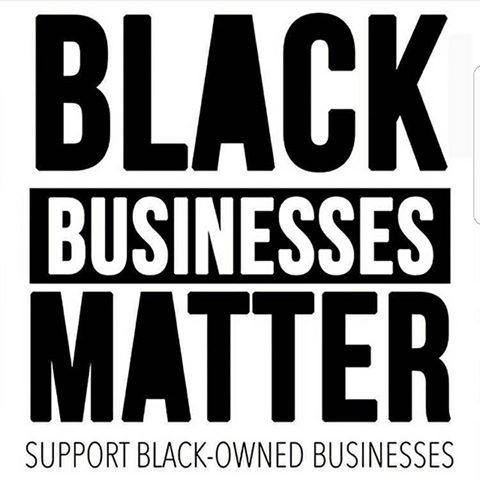
So before I continue, let me say this: Black Lives Matter Too, and Black Businesses Matter Too. Both have been beaten down for too long, and we need to do something about it. I am not buying the All Lives (or Businesses) Matter argument. That’s like saying “But but but...what about me?” For those who are not black, it has been about me, you, and all the others.
As for shelf space, though, that is the most valuable real estate in town, and it must be earned. The only color retailers consider in these decisions is green, the color of money. Otherwise, corporate buyers are color-blind. They have to be, or risk losing their own jobs.
I am worried that if retailers are bullied into doing this, that they will just consider it a charitable donation and write-off those linear feet of shelving. In other words, they won’t take it seriously. It would just be a price of doing business. Worse yet, there is no assurance the products they would carry to fulfill a 15% pledge would actually serve the customers the campaigners represent.
It’s also a slippery slope, because it opens the door to any other under-represented group to complain as well, like small businesses in general (which also characterizes many of the black-owned businesses), Hispanic-owned businesses, etc. Coercing, shaming, or mandating that retailers must allocate their space in certain ways is stifling. Retailers must be free to assemble their product assortment to maximize sales and profits.
Anything else on your mind, Gerlich? Well, since you asked, I also think that large companies from Target to Nike throwing around millions of feel-good dollars to non-profits promoting justice and equity. That’s like saying, “Here’s some money. Now go away.”
You want to help black-owned businesses? Here’s what you do. Invest in them. Since many black-owned businesses lack access to capital, which is needed to grow, now is a good time for Target and others to be investing in these companies, but not more than a minority stake (49%). This way the company can still be majority black-owned, but have access to the money needed to grow.
Black-owned businesses don’t need gratuitous shelf space or donations to noble non-profits. They just need money. Find some promising black-owned businesses, partner with them, and help them stand on their feet and realize their potential. If the product is really that good, and since Target will have put its money where its mouth is, then it will necessarily provide shelf space, because it will have a vested interest.
And everyone wins.
Of course, you can’t just blindly invest either. Accountability is a two-way street. If our large corporations want to show their commitment to the cause, then they need to get in the trenches and work together. Because black businesses and the people behind them matter. That’s what we need to be putting on the shelf.
Dr “Black And White“ Gerlich
Audio Blog
1 note
·
View note
Text
The best way Bitcoin Off shoot Blocks Will be Backward Working - a lot more They’re Never

Through a splash of water in the multimedia, Purse and the in-house-built unique Bitcoin enactment Bcoin a short while ago presented their whole scaling pitch, dubbed “To the Phase of the moon. ” Wheresoever Bitcoin XT, Bitcoin Vintage and Bitcoin Unlimited all of attempt to maximize Bitcoin’s mass size restriction with a challenging fork, along with Bitcoin Central developers like a Segregated Experience soft pay (SegWit), Backpack CEO Phil Lee has announced a third tactic: extension chunks.
Extension obstructs were essentially first recommended by Bitcoin Core coder Johnson Lau in 2013 (as “auxiliary blocks”), in addition to again sooner this year. The best generally conveys many of the benefits of tricky forks: proxy blocks provide almost any standard protocol change. However share just one significant reward with tender forks: off shoot blocks are usually backward works.
Well, like …
Delicate Forks
Very soft forks are generally protocol variations that create new principles or firm up existing models. “Old nodes” - like we’ll get in touch with them for the present time - could consider a soft-forked chain applicable because it will not break almost any “old regulations. ” This causes soft forks backward working: they allow for old clients to coexist on the same multilevel with “new nodes” in which enforce typically the soft derive.
While delicate forks can just only add or simply tighten policies, they can be wisely used to increase Bitcoin’s capacities. To do this, very soft forks ordinarily utilize exceptional Bitcoin contact information known as “anyonecanspend. ” (They’re actually “outputs, ” definitely not addresses, in particular simplicity’s welfare ignore this for now. )
If most of these anyonecanspend the address hold any sort of bitcoins, it signifies that any one can shell out them; virtually no cryptographic bank or everthing else is required! or possibly even longer it seems for you to old clients.
But that certainly is not just what exactly new clients, enforcing the revolutionary rules, find. The new protocols prescribe which the bitcoins during these anyonecanspend looks into can only often be spent less than specific disorders, defined because of the soft hand. These fresh rules can certainly, for example , propose that a element of time probably passed (CLTV) or that your particular signature have to be included in a different part of a new Bitcoin prohibit (SegWit).
File format Blocks
Extendable blocks be like soft forks, but fairly literally take their concept to an alternative level.
An extension with conservatory block per se looks smilar to a normal Bitcoin block, which in turn we’ll name a “base block. ” Like a bottom block, an extension with conservatory block largely includes a crowd of transactions.
Although there is a variance. A base obstruct is cryptographically linked to the former base wedge and to next base mass, chaining most of base hindrances chronologically to make Bitcoin’s blockchain. An extension prohibit, on the other hand, one way links only to a person corresponding bottom part block. Proxy blocks “peg along” basic blocks.
Similar to soft forks, extension pads utilize anyonecanspend addresses. Now, these anyonecanspend addresses work like enter plus exit tips, to and also from the file format blocks.
Any time a transaction is definitely sent at a base obstruct to an extendable block, an ancient node can be tricked. With the perspective of your old computer, the money are deliver to a typical anyonecanspend address for the base wedge. The gold coins never give the base mass as far as outdated node can be involved, and in point the old computer doesn’t possibly see the proxy block.
Nonetheless from the view of a brand-new node, often the bitcoins are very sent to a total new deal with on the off shoot block aid an “extension address. ” This file format address plays its part more or less as being a normal Bitcoin address.
Perhaps surprisingly, these bitcoins can then perhaps start to flow into from extendable address to help extension street address, from one proxy block to another location. As such, completely new nodes to view coins moving and switching ownership. Also, old clients do not discover anything along with think the exact bitcoins are nevertheless stuck during the original anyonecanspend address.
A different node may send the particular bitcoins using their company extension handle back to a regular address in the base prohibit. This is produced by tricking outdated nodes for a second time: from the mindset of the previous node, typically the coins usually are finally migrated from the anyonecanspend address. Only one new computer knows the spot that the coins seriously came from.
If the bitcoins will be back in the starting block including a normal target, old in addition to new clients see the ditto.
As maybe there main great extension chunks, they don’t really need to adhere to an original Bitcoin method in any way. The following opens up a full category of innovative possibilities. Recognized blocks might perhaps deliver more programmability like Ethereum or Ethereum Classic, and up privacy including Monero, Zcash or Mimblewimble.
Bcoin’s proposition is minimal, however: “To the Moon” extension obstructs are mostly simply just bigger than ordinary blocks (by a so-far unknown amount), so they can tackle more ventures. They also involve Segregated Observe, and some beneficial properties specifically made to support often the lightning market on top of recognized blocks.
Sophistication
While off shoot blocks usually, and To the exact Moon specially, can work each year, they do offer some negative aspects.
At the heart of them drawbacks, On the Moon is much more technically difficult than other your current solutions planned so far, as well as all very difficult forks along with a Segregated Find soft division. This also generates more complicated that will implement.
In addition to from a individual perspective, Into the Moon could leave good old nodes unaware more than a lot of soft forks do. Though old clients don’t discover coins for soft-forked anyonecanspend addresses is often spent, by using extension hindrances, old clients don’t even find out where loose change are. Consequently old clients can’t hint the history on the coin as well as in some cases quickly can’t quite possibly spend them. (This would be the case in cases where a blockchain reorganization takes place; this will likely cosmetically switch what a exchange from an file format block a good old computer looks like. )
As such, never everyone loves Towards Moon. Perry Lau, the very first proposer connected with extension pads, argues of which To the Moon phase “failed in order to reach the very necessary requirement of your softfork: toward the back compatibility. ” He on the other hand still looks at extension chunks “more for an academic subject matter than a little something really looking forward to production apply. ” In a similar fashion, Bitcoin Main developer plus Bitcoin Take away the maintainer Lenny Dashjr alerts that extendable blocks “are a chance of creating not one but two classes with ‘full clients, ’" wheresoever non-upgraded clients are "left insecure for instance pseudo-SPV (not even serious SPV) clients. ” Plus Bitcoin Center developer Sofia Corallo dismisses the idea that proxy blocks might be of interest opt-in in anyway - as a substitute “the full network will trust recognized block, ” a “pretty terrible antecedent. ”
1 note
·
View note
Photo

SIMPLE THINGS YOU CAN DO TO AVOID AN IRS AUDIT
Tax Help, Audit Help, Tax Debt Relief
IRS audits are the worst, aren’t they? So, it pays to avoid them if at all possible. The best advice is to be entirely and totally honest on your tax returns. Otherwise, if you follow these tips, you could keep the IRS from knocking on your door in the near future
1. Report ALL Income
Yes, you have to report all of your income. Taking money under the table, “forgetting” about that 1099, or leaving anything off your return is a bad idea.
Those 1099s? The IRS receives a copy, too. They expect to see it on your return.
Are you a gambler? Report all earnings as well as losses.
Don’t pad anything.
Are you an investor? Report all of your capital gains and interest. The IRS gets most of that information, too. By the way, if you dabbled in cryptocurrency, it should be treated as an investment, not currency.
Always, always, ALWAYS file on time and file everything correctly. An amended return can trigger an audit, so be sure everything is complete before you or your tax professional hit “send.”
NEED HELP WITH IRS BACK TAXES, AUDIT REPRESENTATION OR SMALL BUSINESS TAX PREPARATION?
ADVANCE TAX RELIEF LLC
www.advancetaxrelief.com
BBB A+ RATED
CALL (713)300-3965
2. Report Overseas Accounts
If you have accounts in a foreign country, you must comply with the Foreign Account Tax Compliance Act, aka FATCA. And don’t forget about the Foreign Bank and Financial Accounts (FBAR), which files reports with the Financial Crimes and Enforcement Network (FinCEN). The movies are wrong, there is no such thing as a private Swiss Bank account where you can hide money from Uncle Sam.
Failure to comply with FATCA a costly proposition.
3. Watch Those Deductions and Credits
Deductions and credits are great. They can lower your taxable earnings as well as the amount you owe. Just don't abuse them. The IRS knows these are popular items, and they will find out.
Avoid claiming large itemized deductions. If your deductions are out of line with your income, the IRS notices.
Don’t take the Earned Income Credit unless you actually qualify.
Be honest about things like mortgage interest deductions because the IRS gets a copy of those forms, too.
If you are self-employed, you may write off quite a bit in supplies, equipment, and costs. But don’t get carried away.
Keep scrupulous records - you may need every supporting document possible if you do become an audit target.
We get it. Those credits and deductions look mighty tempting when you owe the feds money. But if you can’t qualify without squinting, don’t take them.
4. Take Care with Rental Losses and Real Estate Businesses
If you own rental property, you will probably suffer losses for some years. However, if your losses become a habit or are more extensive than your tax professional can stomach, be absolutely sure before you write those losses off.
The Tax Cuts and Jobs Act cut ordinary income tax rates for rental owners and kept the long-term capital gains tax for when you sell. But rental losses really complicate matters. Something else that you should know: the IRS allows you to deduct up to $25,000 in losses, but only if you actively participate in the renting of the property.
One more thing. Don't claim to be a real estate professional if you are not. To qualify, you must spend at least 750 hours a year and spend more than half your time working to be considered a real estate professional. Document every single hour you spend on your real estate business, just in case.
5. Classify Your Employees and Independent Contractors Correctly
Sure, it's tempting to call everyone who works for you an independent contractor. That way, you don't have to withhold income taxes, take care of W-2s and W-4s, or any of that other stuff. Unfortunately, if the IRS decides your “independent contractor” is actually an employee, you could be in a heap of trouble.
Independent contractors maintain their independent status by doing the work the way they want and when they want. You just control the finished product. When you start telling them exactly what to do, which tools to use, and when to work, they become employees.
6. Don’t Claim a Hobby as a Business
Hobbies are fun. Some of them are expensive. You may think you can save yourself some money by claiming it as a business and getting those nice business expense deductions.
Just stop. Don’t do it. If you can’t afford your hobby without defrauding Uncle Sam, maybe you need to find a different hobby. If gambling is your hobby, please refer to #1 above.
7. Don’t Claim Dependents You Don’t Have
So far, all attempts to have furbabies declared as dependents have failed. So, don’t claim Fifi on your taxes. Also, be sure your children actually count as your dependents. Things get tricky if custody is shared between divorced parents or a couple filing separately. You can’t both claim the little devils unless you file jointly.
Also, once they turn 19, you can no longer claim them unless they are full-time students. Too bad the deduction doesn't help pay off college, right?
8. Don’t Inflate Business Expenses
While you should report business expenses, don’t get too carried away. Make sure you have all the proper documentation and that you followed IRS rules.
If you use a vehicle for business, you can deduct mileage for work travel.
Home office supplies, equipment, and certain costs are eligible. Just be sure to follow the rules.
Don’t try to write off meals or entertainment unless you can prove they are business-related.
As always, meticulous record-keeping is your defense.
9. Give to Charity, but Don’t Overdo It
Like business expenses, don’t inflate charitable gifts, either. (By the way, political contributions don’t count.)
For all donations, cash, goods, or services, get a receipt. Also, make a record of everything you donated.
10. Only Submit Error-Free Returns
Double and triple check your returns. You want no math errors and no blanks, especially where your signature should be. It's incredible that people do all the work of preparing a tax return and then forget to sign, but it happens.
As honesty is the best policy, make sure your reported income matches your tax documents. Don’t fall for any of the IRS Dirty Dozen tax scams that leave you holding the bag.
This isn’t an exhaustive list of ways to keep out of trouble with the U.S. government. But it can get you started down the right road. Report everything, pad nothing, and remember to sign before sending your return
Oh, and filing paper returns seems to get IRS attention these days, so you’d better e-file. Let us know if you need audit representation.
GET TAX RELIEF HELP TODAY
If you think that you may need help filing your 2018/2019 tax return or past due tax returns, you may want to partner with a reputable tax relief company who can help you get the max refund and reduce your chances for an IRS AUDIT.
Advance Tax Relief is headquartered in Houston, TX with a branch office in Los Angeles, CA. We help many individuals just like you solve a wide variety of IRS and State tax issues, including penalty waivers, wage garnishments, bank levy, tax audit representation, back tax return preparation, small business form 941 tax issues, the IRS Fresh Start Initiative, Offer In Compromise and much more. Our Top Tax Attorneys, Accountants and Tax Experts are standing by ready to help you resolve or settle your IRS back tax problems.
Advance Tax Relief is rated one of the best tax relief companies nationwide.
#TaxDebtHelp #FilingBackTaxesHelp #TaxReliefHouston #BackTaxRelief #TaxAttorneysNearMe #IRSLawyer #TaxReliefFirms #OfferInCompromise #TaxResolution #LocalTaxAttorney #HelpFilingBackTaxes #TaxDebtSettlement #TaxReliefAttorneys #IRSHelp
0 notes
Text
Since our last vlog, it didn’t make much sense to do video updates over December as we weren’t together much – after our blitz of pharmacy and web agency meetings, we were able to crack on with most of our to-do list independently, so we left the rural idyll of Burley in Wharfedale and worked from our homes in London and Leeds.
We’ve made good progress since December, and are on track with where we wanted to be, but the unavoidable delays that are stopping us from being able to launch RIGHT NOW are frustrating. Whether it be turnaround times with the web agency, or the 90-day lead time for receiving government approval to sell medications online, or delays in product and packaging deliveries from suppliers, we know we just need to be patient, but at the same time we just really want to be in launch mode, growing the business and making sales. The pre-launch phase is very introverted and internally-focussed, and it’s neither of our natural domain. Anyway, it is what it is. We’re just focussing on making sure we get all the internal pieces in place at the highest quality so we’ve got the best platform for when we launch.
Here’s the main updates of what we’ve been doing since early December and what we’re focussing on now.
We’ve firmed up our branding and logo
We had a full day workshop with our web agency in early December to firm down the branding. We already had a clear idea on our target audience and how we wanted to the brand to come across. It’s simple really - we want to sell products to people like us and a lot of the people we’re mates with.
Our target audience aren’t narcissistic Love Island wannabes, over-obsessed about their looks and living life for the ‘gram, but nonetheless, we want to appeal to guys that have a bit of get up and go, and believe it’s important to take pride in their appearance whilst maintaining perspective on the more important things in life. For men like this, we believe convenience and ease can be the tipping point on whether they’ll make a decision to buy something or not. A base assumption of our proposition is that by providing a really convenient ‘whole service’ that educates men on the causes of common health and wellness issues; provides easy access to quality treatments; as well as the facility to easily purchase and receive treatments to their home without the need to see a GP or visit a Pharmacy, we’ll make the buying decision a no-brainer. If we can make sure to deliver this experience in an ultra-responsive way and wrap everything within a slick brand, then all the better.
So, anyway, we needed a logo to reflect the sort of vibe that would appear to these type of men. Something slick and cool; modern rather than flashy; but also warm - we’re a health and wellness brand so need to come across as trustworthy and open.
Our agency mocked up a few examples which we put to a vote on Insta. Here’s the countdown.
3) In third place:

We like the slickness and imagery of the double M on this, but felt it was too angular for a health/wellness brand.
2) In second place:

We like the word mark on this one, but felt the logo was a bit too simple/generic.
1) In first place


This got the most votes by a decent margin, and we liked it too. However, it still didn’t feel quite ‘right’. We didn’t love it. The logo looked too sharp, and for a health & wellness brand, we felt it was important that it came across warm. So we thickened the logo, changed the font and ‘voila’ – our final logo:

We’re really pleased with it.
Pharmacy & GP Discussions
Because we’ll be selling a range of prescription (and non-prescription) medication, we’ve needed to partner up with GP’s (who will issue prescriptions off the back of online consultation forms generated through the site), and Pharmacies (who will receive the prescription order from the GP, dispense the medication, package it into our bespoke packaging, and arrange delivery to the patients home). Our main focus after starting the business in November was getting these partnerships in place. We’ve now agreed deals with two Pharmacies (we’ll provide more details on these later) plus a GP, with a few others expected to sign shortly. So we’ve been pleased with that, but we’ve got more work to do to tie down all partnerships over the next couple of weeks.
There’s been a few complications along the way. The GP who agreed to work with us then had to backtrack due to having too many other commitments. Complications with another GP who had issues securing the additional medical insurance needed to cover them for online consultations at a so-far-unlaunched start-up. The difficulties of finding GP’s with both the shared vision of what we’re doing, as well as the entrepreneurial drive. But over the last week we’ve had some really positive discussions and are confident we’re now good on this front.
Product Sourcing
For launch, we’ll have three main product lines - Hair, ED (erectile dysfunction) and Teeth.
Sourcing the ED products is simple – all three products in our launch line-up, Sildenafil, Tadalafil and Viagra Connect, can all be easily sourced by our partner pharmacy via their existing arrangements with their pharma manufacturers. The same applies for our prescription hair growth pill, Finasteride. The pharma manufacturers have slick supply chains that mean they can arrange two deliveries a day, so we don’t need to bulk buy lots of meds in advance – great for cashflow. All of the meds (apart from Viagra Connect) are available in generic form, meaning we can provide the product in our own branding and packaging at price competitive rates.
For the Hair category, we’re looking to launch with a bundle of products that prevent hair loss. These include the only two medically proven treatments in the world for male pattern baldness – a daily pill treatment Finasteride (effective in 9 out of 10 men) and a topical spray called Minoxidil (effective in 2/3rds of men). We’re complimenting these products with Biotin Gummy Vitamins, which strengthens hair follicles, and a Shampoo with ingredients such as Ginger, Copper Peptide and Sophora Flavescens, which have been shown to stimulate healthy hair.
Minoxidil has been a lot trickier to source, as the only licensed option on the market is a branded solution called Regaine. This is a problem because Regaine is expensive and it has a high alcohol content so can sometimes inflame the scalp. It's also expensive to buy-in, so we’d find it difficult to make worthwhile margins, and we also wouldn’t be able to use our branding on the packaging, ruining the aesthetic of our bundle pack. We’re still working with a few specialist pharma suppliers with a view to getting a bespoke low or zero-alcohol Minoxidil formula that our GP’s can prescribe as an alternative – this is one of the key streams we’re working on this week.
For the remaining products - Biotin Gummies, Shampoo, and the Teeth Whitening kits, we scoured Google, searching different UK Manufacturers and Suppliers, as well as using Alibaba – the Chinese ecommerce giant that seems to sell everything.
The key with product sourcing is finding a supplier who can deliver:
1. Low minimum order quantities (MOQ’s). A lot of manufacturing companies only go into production off the back of custom orders, and would often require minimum orders of 10,000 units. We needed to find a supplier who was able to accept orders for 250-500 units to begin with,
2. Own-label products. Everything we’ll be selling will be under the ‘Man Behind The Mirror’ branding. Own-label is easy if you’re ordering high minimum orders, but getting own-brand and low minimum orders can be tricky.
3. High-quality products from a high-quality supplier. It’s important that every product we sell on the site is high quality and effective, and we needed to make sure the suppliers we worked with are legit. That's difficult when they're on the other side of the country, but Alibaba has a good supplier ratings system, so we focussed on working with suppliers that had plenty of positive reviews on the site.
4. Great prices. Obviously.
For the Gummies, we found a good UK supplier just before Christmas, with low minimum order quantities provided in unlabelled jars that we can brand ourselves. They tasted good too and contained all the ingredients we were looking for – primarily Biotin, but also Zinc and a range of other Vitamins.
For the Shampoo, we found a Chinese supplier on Alibaba. Dealing with suppliers on Alibaba is interesting… Their factory sales reps communicate largely over Whatsapp text and video calls, they’re very informal (flirting and sending love heart emojis seem to be a standard negotiation tactic) and whilst their English is generally good, the language barrier is sometimes an issue in getting clarity on specific things. Importing from China also opens up a raft of new considerations – luckily no import duty applies importing shampoo from China, but we still needed to register an account on the government’s import tracking system and get a freight forwarder in place to pick up our goods from the port and deliver them to the UK. Not a big deal, but the sort of faff you don’t need to worry about if buying from the UK.
For the Teeth Whitening Kits, we came across a supplier on Alibaba that fit the bill very quickly. Great supplier ratings from customers. Well established. Highly responsive to enquiries. Low minimum order quantities. High quality ingredients equivalent to the market leader in the space. Customised packaging using our own branding. Perfect. Here’s a pic of how the kits look:
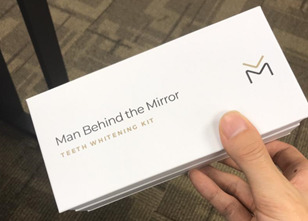
Draft Photoshoot and visual style for the brand
In early December, we drafted in a few of our (better looking) friends to help us with a practice photoshoot to help us figure out the vibe and type of pictures we wanted to use for the website proper. The day was a good laugh and we got some good pictures that represent the vibe of the brand we want. Thanks to Geo, Julian and Philip, as well as Alberto for letting us use his incredible flat as a location. Here’s a few pics from the day:


We’re arranging a follow up shoot for late Jan with a professional photographer to nail down the actual pictures we’ll be using on the website.
The Website
Our web agency have been cracking on with the website design and build over the last few weeks, and are on track to have it finalised by the end of January. Because we’re selling prescription medication, there’s a few things that have made the project a bit more complicated than a standard ecommerce build.
Firstly, men who want to purchase our prescription treatment need to be able to complete an online consultation questionnaire through the website, providing information around their medical history and type of hair loss that would help a clinician decide if they’re willing to prescribe or not. We need a really slick customer journey, so that when someone visits the site, they can easily learn about the causes of their health/wellness issue, discover the treatments available to them, complete a quick online consultation questionnaire, make a purchase, and then have their treatment delivered to them in a couple of days. We’ve worked with our web agency on a solution that integrates different plug-ins to deliver the functionality we need without the major costs of a bespoke build (we found out one of our main competitors spent over a quarter of a million to build their website….. suffice to say ours was no way near that!).
Another complication is that if you want to sell things online, you need a payment processor relationship to handle payments. If you’re selling normal everyday products, there’s generally no issue getting a payment processing relationship in place. However, for ‘non-standard goods’, (such as prescription medication) these companies can be veryyyyyy risk averse and have separate rules and checks for working with businesses – particularly start-ups – who are selling these things. So that’s another complication we’re currently working through, but we expect it’ll be sorted in the next couple of weeks.
Finally, the biggest roadblock for the website from a delivery perspective is the UK Government regulations on selling medications online. We’re working with the regulator, the MHRA, who need to review our website – checking the content, website flow, T&C’s, etc, to make sure we’re positioning and selling our products appropriately – before they can grant us approval to sell our Hair and ED products on the site. The downside is this process can take as long as 90 days (!), and we can only apply when the website is at a near-finished stage that the MHRA can review. The website’s going to be in a good enough condition to make the submission this week, and our pharmacy partner has assured us the process is much quicker in his experience, but nonetheless, it’s a risk, as ideally we want to launch in mid-February. If the worst comes to the worst and the MHRA process drags, we may need to consider launching the site with the Teeth products first and then launching with the prescription medication a bit later, but we really don’t want to do that, so fingers crossed.
Product Packaging
Our main focus this week has been nailing down slick packaging for all of our products. So scouring the web for different suppliers of cardboard packaging; plastic bottles; ziplock bags; pill jars; etc. We’re trying to find bottles and outer packaging that looks great, is cost-effective, and is consistent with the other packaging within each pack (e.g. for our hair products, we need to ensure a consistent colour and visual scheme across all the bottles and packaging). We’re also trying to make sure all our packs can fit through the letterbox, as that will put us on a cheaper delivery tariff and help us deliver the best customer experience. We made a bit of a breakthrough today – design concepts should be sorted by late Jan.
The Marketing Plan
So, now the fun bit. We’ve got a holding site ready on manbehindthemirror.co.uk and we’ve set up social channels on Instagram, Facebook, YouTube, TikTok and Twitter, but as yet, we haven’t done any promotion for them. Basically, we’ve wanted to make sure we’ve got a solid backlog, schedule and pipeline of social media posts to ensure momentum when we do go into promotion mode before we start spreading the word but by the end of this week we should be in action mode.
Over December, we worked with the University of Leeds who were great at helping us recruit three interns to help us build our marketing content out. We’ve hired Daniela and Venetia, two very talented Media & Comms students, who have experience across graphic design, photography and video publishing/editing, as well as Matt, a PHD student in Graphic Design.
After studying what our comps have done well and not so well across diff platforms, we’ve got a good feel for how we want to do things, and we’ve spent the last couple of weeks building up a database of online content ideas, and we’re working together this week to flesh these out into posts we can start publishing – whether they be photos, videos, interviews, blog posts and more. We’ll explain more in future vlogs about the marketing plans as over the next couple of weeks it’ll increasingly become the main thing that we’ll be working on, so watch this space.
So, that’s what we’ve been up to. We’ve still got a few roadblocks in our way that are stopping us from launching imminently, but we’re hopeful that, provided the MHRA application goes smoothly, we’ll be able to launch in mid-February. You’ll see a lot more activity from the Man Behind The Mirror social accounts well before then anyway.
0 notes
Text
Trump and the Greenland situation
I wanted to take a closer look on the Greenland situation that broke down in august 2019. Trump fired up one of hes famous tweets, wanting to buy Greenland from Denmark. This situation was very intresting to me, and it was made even more intresting by hearing a lot of missguided information or one sided information. First up I had a look on a Guardian article on what Trump supporter Tom Cotton from the senate had to say.
Angle of a Trump supporter

Hes main point is that Trump is crazy like a fox with hes tweets. He arrived on this conclusion based on Greenlands potential strategic importance to the USA. “Donald Trump was “crazy like a fox” when he floated the idea of buying Greenland because the move would secure vital strategic interests for the US” (Martin Pengelly 08/19)
the US has a presence in Greenland already, but especially after China among other countries has showed interest in the area, US wants to solidify their standing in Greenland. China has tried to build airports to Greenland and according to Tom Cotton those attempts failed because of the lobbying by the Trump Administration.” attempts to build airports on the island by China, a country which occupies a central piece in Trump’s thoughts and US foreign policy. Those attempts “failed only after intense lobbying of the Danes by the Trump administration”, he said.” (Martin Pengelly 08/19).
Some people have taken Trumps tweets as a undirect message to namely China and Russia as a warning to back off from Greenland. Greenland belongs to a US ally Denmark. “This weekend Nils Wang, a former head of the Danish navy, told the Sunday Times: “Trump’s approach may be wacky but it does send a serious message to Russia and China – don’t mess with us on Greenland. This is a complete game-changer.” (Martin Pengelly 08/19).
Greenland at the moment is costly for Denmark, so even tough Greenland has immense economical potential in the future at the moment its economics are not in a good state. “Their considerations ought to include the fact that despite Greenland’s long-term potential, a lack of infrastructure and financing still hamstring the island’s economy today. Greenland’s economy is less than one-tenth of Vermont’s, America’s smallest state economy. Every year, Denmark transfers $670 million in subsidies to support the island.” (Tom Cotton 08/19).
I chose to write this part mainly from Mr. Pengelley’s article since it’s easier to access. The last quote is straight from Tom Cottons opinion piece, and you might need to make a New York times account to access it. A shortened quote can be found from Mr. Pengelley´s article. This part is good for readers to understand the positives and reasons behind Trumps tweets. It tries to defend the lack of thinking behind the tweets and does not show the negative sides of the story very fairly, readers should keep it in mind that the article is based on a text written by Tom Cotton an avid Trump supporter from senate.
The Angle of buying land in the 21th century

This article was a great find its written by law professors Joseph Blocher and Mitu Gulati. It is written by professors and in my opinion is unbiased which is an incredible rarity when talking about anything that has something to do with Trump. This is something that Mr. Trump should have read before firing off his tweets.
First off in the article we find out that idea behind buying Greenland not as ridiculous as many of the Trump critics thought. It was quite usual for countries to be sold until the first world war. “In the first phase of this ridiculous news cycle, the internet critics got something wrong: Conceptually speaking, a purchase of sovereign territory isn’t all that outlandish. (Sovereign here meaning any land tied to a government; not necessarily self-governing.) As a historical matter, such transfers were a regular occurrence up to around World War I.” (Blocher, Gulati 08/19)
Of course, this was a long time ago. A lot has changed in the last 100 years and selling and buying land is not as easy as it was in the past. This was Trumps biggest mistake in this whole situation. In the present you can’t just ask Denmark to sell you Greenland, the most important people in that transaction are the people of Greenland. This deal is nothing like a real estate deal like Mr. Trump said. “If Trump wanted to purchase Greenland, Denmark wouldn’t be the most important party—the people of Greenland would be.
Trump seems to be under the impression that sovereign purchases work as they did in the 1800s. When the United States bought the Louisiana Purchase from France, the people living in that region had no say.” (Blocher, Gulati 08/19).
So, If Trump wanted to buy Greenland how should he go about it? Well like previously mentioned the most important party in this deal would be the people of Greenland. Trump would not even necessarily need the approval of Denmark although considering these two countries are allied, they probably would want that. Trump would want Greenland to have some kind of a people vote to join the US. “Trump’s Greenland fantasy is a long way off from realization. But if it were to happen, it would be through a process that Trump has yet to invoke: one that depends on approval of the transferred territory itself, ideally through a popular referendum or legislative vote.” (Blocher, Gulati 08/19).
Trump is about 100 years too late with he´s real-estate comment “the core idea of purchasing sovereign territory is hardly unprecedented. But until the early 20th century, transfers of sovereign territory required the consent of only the two nations involved, and not that of the people living on the territory itself. Under the old rules, nations could essentially treat their sovereign territory like property; Trump’s real estate model would have been quite appropriate.” (Blocher, Gulati 08/19).
After the WW1 the rules of buying a country changed. The decision was given more to the people who live in that country instead of the country that rules them. This rule was used a lot in the 1950´s and 1960´s when many countries sought independence from their rulers. For example, India.
Here is a hypothetical on how the US could by Greenland from the article.” This is how you might go about buying Greenland in 2019. First, negotiations would need to involve at least the United States, Denmark and Greenland, rather than the first two alone. (If Greenland were to first become independent, then Denmark would largely drop out of the conversation.) Second, terms would have to be proposed that would satisfy all of the interested parties. Those terms might be largely financial, but not exclusively so: The people of Greenland might want U.S. citizenship, or even statehood (so as to avoid Puerto Rico’s fate). Third, approval would have to be secured—most importantly, from the people of Greenland. Ideally, this could be done through something like a referendum, perhaps with a supermajority requirement, given the importance of the question.” (Blocher, Gulati 08/19). To me this does not seem that impossible. At the current time Greenland is quite poor and being a part of US could be a big benefit to them. It seems though that Greenlanders are more interested in preserving their culture instead of getting rich so it might be a tricky sell.
Some other intresting toughts

So as seen in this article, Trumps tweet was ridiculous, but it was not impossible like many people said. Even said that I think it’s close to impossible that Greenland would be owned by the US in the future. I do find it very likely though that US will greatly make their presence bigger In Greenland. “The state department said in a letter to Congress that re-establishing a consulate in Nuuk is part of a broader plan to increase the US presence in the arctic. A copy of the letter was obtained by the Associated Press.” (Associated press in Washington 08/19). It seems that after Trump realised acquiring Greenland would be too hard, he’s settling on opening a consulate in Greenland. Trump might have shot himself in the foot when he did the buying offer. The article predicts that now getting the bill trough will be harder.” Congress would likely have been open to the idea, but after Trump’s actions the proposal will likely gain greater scrutiny.”
So why is Greenland so important to US. One part of it has to do with the trade war. According to a Finnish newspaper Kauppalehti in Greenland there are some rare minerals and metals that are unused at the moment. Presently China mines and sells 70% of these minerals, to secure tech and automobile production in the US, it would be good for Trump to find another way to get these minerals.
The second reason is to strengthen the position of the US in the artic. Currently Russia has a growing presence in the artic, and also China has shown interest to the Artic, as mentioned in this text previously.

Just to quickly go through the sides of Denmark and Greenland. Basically, in both countries the proposition was taken in a way that they thought Trump cannot be serious with he’s proposition. If you wish to read more about the Danish perspective I recommend this article by Jens Lei Wendel-Hansen who is a Postdoctoral researcher, from Department of History in University of Southern Denmark.
If you wish to get a Greenlander perspective you should read this article from various people from Greenland.
0 notes
Text
Before you quit your job to stream games for a living, you’ll need a viable business model.
Streaming video games online for money seems like a no brainer for some, but doing it for a living can be rather complicated. After hearing many horror stories of streamers who quit their jobs and then couldn’t pay bills or rent, I decided to write an article about the streamer business model and the risks involved. This article is focused on Twitch. While YouTube Gaming and Beam have potential, they currently do not have the gamer viewer base of Twitch. It’s hard enough to do this as a living without adding risk of low viewer base into the equation.
1. What is a Twitch Partner?
Becoming a member of the Twitch Partner Program is a key component of the streaming business model.
It unlocks:
• Share of the ad revenue generated from all broadcasts on channel.
• Monthly subscription revenue from viewers.
• Stores for selling custom apparel.
• Tips and cheering revenue from viewers via Bits.
• …and more but those are the major revenue implications.
There is an application process for becoming a partner with the following guidelines.
2. What’s Your Unique Value Proposition?
Streaming video games has quickly become a crowded space. It’s already difficult to stand out by randomly playing video games for viewers.
Streamers need to define a “niche” to build upon.
• Are you funny or skilled… or both?
• Some viewers will care more about skill and want to learn versus others who want to be entertained and don’t care that much about skill.
• Ideally streamers can be both skilled and funny.
Questions to ask before going all-in on streaming:
• What types of games do you enjoy playing?
• What types of games are you skilled at playing?
• What games are already oversaturated with streamers?
• Do you want to skew toward being entertaining or informative?
• What is your schedule for streaming each week?
3. How Do Streamers Engage Customers?
Streamers deliver their value through the Twitch Platform channel, which supports multiple screens.
Streamers need to think about how to get, grow and keep viewers. Having 100–200 viewers consistently is a great start, but that number needs to grow if the goal is to pay rent, bills and food with the profits.
Engaging viewers on the stream through Twitch Chat is necessary, but it is not sufficient.
Streamers now have Twitter, Facebook, Instagram, YouTube and other social media channels for getting and growing their viewer base.
Creating and growing these additional relationships takes time, effort and money. Follow a few of the popular Twitch Streamers and do some research on what links they provide on their streamer page.
4. How Do Streamers Make Money?
Streamers do not simply sit back and watch the cash roll in. This is a huge misconception that is overshadowed by the passion for gaming. Generating revenue is rather complicated and aspects of it evolve as Twitch and other services change over time.
• Ads — Streamers Ad Revenue is calculated flat-rate CPM basis. While this won’t be the major revenue source, it can add up with stream duration over the course of time. The problem is that many viewers use ad-blockers, and do not count towards CPM.
• Subscriptions — Viewers subscribe for $5/month but depending on the streamer’s contract, Twitch reportedly takes 50% of that $5 (or $2.50). There are ways to negotiate the streamer % up over time to a higher share of the subscription revenue, but since Twitch doesn’t allow these contracts to be public, it is a black box on how this actually occurs. Twitch will soon allow higher subscription amounts above $5/month, but that structure is still in beta.
• Donations — Donations can be a major part of the streamers revenue. Viewers can donate $ through services like PayPal directly to the streamer. The streamer can set minimum donation amounts as well. This can get tricky over time however because people can request their donation back from PayPal, which we’ll cover next in the Cost Structure section. Twitch has introduced Cheers, which are powered by a micro-currency called Bits to allow viewers to contribute smaller amounts of to the streamer more frequently. A streamer receives $0.01 per Bit so the larger the number of Bits, the more $ for the streamer
• Merch or Apparel Sales — Twitch partners with Teespring so that streamers can design and sell apparel in the official Twitch store. Twitch takes $2.50 of each transaction and there is a base cost to manufacturing the t-shirts. This will likely not be a significant revenue source right away without a large volume of sales over time.
5. What Do Streamers Need And What Will It Cost?
Streaming requires activities and resources which will result in the streamer incurring costs. These costs can vary based on the style and content but there are some commonalities. Ideally costs are less than the revenue, however many streamers do not model this out early on and are surprised when they lose money.
• Hardware — Streamers need desktop or laptop to play games and usually another to live stream video to the internet. Depending on the system requirements of the game, this can add up quickly. Most mid-range gaming computers cost an upwards of $2000. Many streamers have a green screen setup with a camera and lights so that they can do more with graphic presentation of the stream. They also need decent gear like headphones and mic so that viewers can interact with them.
• Software — Video Streaming requires a high end internet connection and some software to have a professional looking stream setup. Twitch has a helpful guide here to get you started and there are Twitch Startups popping up every few weeks it seems. Most are geared towards providing streamers more insights into their viewer behavior.
• Production — In addition to streaming, viewers expect perks for donating money and subscribing. Custom badges and emoticons are all the rage and show super-fan status among viewers. These take some graphic design skill and money to create unique perks.
Taxes & Fees — Streamers need to be prepared to pay taxes and fees associated with streaming. The biggest elephant in the room at the moment is the dreaded PayPal Chargeback. Viewers can contribute donations through PayPal and streamers reaction may be to withdrawal the money right away and spend it. However PayPal allows viewers to reverse the donation, which if approved, will put the PayPal account in a negative balance. There are a few tips to help mitigate this but neither are bullet proof. First off do not touch the PayPal donations within the first 90 days, no matter how tempting it may be. Second include a disclaimer on the streamer page about donations that makes it clear there are no services in return for the donation. After all, it’s called a “donation” for a reason. Unfortunately the terms and services for payment systems still allow this headache for streamers.
Streamers can create partnerships where the costs incurred are driven down significantly. Streamers partner with outside companies that bring activities and resources so the entire burden is no longer on the streamer.
Partnering with Twitch is a must because streamers need to unlock the perks of being a Twitch Partner.
Energy Drink companies are an ideal target because some of the games people play feature their products. It’s no surprise that gamers are their target audience. Energy Drink companies can provide perks which streamers can give away in contests.
Gaming companies (both hardware and software) are great partners because they may provide a gaming system and accessories for both the streamers and for giveaway contests.
Speaking of partnerships and brands, this is where streamers can unlock even more revenue.
6. How Do Streamers Integrate Brands?
Brands love streamers, although they are still trying to find their way on how to engage with them. Streamers on the other hand need to do more than wait for brands to come to them.
I’ve illustrated brands in green below:
Streamers have to uphold an image that will not damage the brand. The value proposition to the brand is slightly different than the value proposition to the gamers. Brands care much more about appearance and expanding their sales channels.
• There are a few brand / streamer marketplaces now that connect both sides such as Ader and PowerSpike.
• Brands unlock new revenue streams with sponsorships and affiliate programs for streamers. This is especially helpful if streamers want to use this platform as a foundation to jump other gamer communities and events.
• When including brands into the equation, the streamer business model expands from a straight B2C play, and into B2B.
• Companies like Razer are already jumping on this opportunity and streamers can benefit from it.
7. Making The Model Your Own
I’ve detailed out the high level commonalities and risks of the streamer business model and while helpful, becoming aware of this complexity is only the first step.
Next you’ll need to put numbers behind each of these pieces and apply them to your unique situation.
Make it your own and good luck!
0 notes